#also a lot of reviews tend to focus on gameplay. which is fair. but also. pls the story
Text
it’s not the most popular game out there or anything, but it’s a relief alan wake and other remedy games have fans because if i had to stew in my own thoughts over these games, my brain would explode from the pressure from keeping it all in
#when control came out i felt the exact same way#but somehow it felt less popular 😭#also a lot of reviews tend to focus on gameplay. which is fair. but also. pls the story#this is going to sound contradictory but i do prefer that remedy games have less/calmer fans compared to popular games#just seeing Some people miserable over the game simply teaming w a sensitivity company was already enough#but mostly fans seem nice ! and surprisingly a lot of fantastic reviews from people both over the story and musical#that support so remedy can keep making their confusing and wonderful games is nice to see#might delete
64 notes
·
View notes
Text
unsourced DA4 snippets under the cut:
(Please remember that these are just offhand comments, don’t read too much into them or jump to conclusions. The game is still years out, we know next to nothing about it and many things could change between now and release.)
Q.) Does DA4 have ray tracing? A.) All they can really say right now is that they are taking advantage of the new hardware. When they’re ready to show gameplay we’ll know for sure
A lot of dev creativity comes from them being able to play around with different ideas and such for a while in “DA Weeks”. These are internal periods when the devs can pursue different individual creative projects that in some way benefit DA, and were talked about in the 25 Year Book [ctrl-F “giants”]. In DAI for example the giant mobs were the result of one of these. A surprising amount of stuff from these weeks makes it into the games because they’re things individual people are really passionate about. Something in one of the DA4 videos that have came out so far was actually the result of a DA Week, but they can’t say what specifically
The timing for when to announce or show stuff is always tricky. They know people are hungry for as many details about the game as possible, indeed any, but until the game is done it isn’t done. This sounds obvious but [the point being made here was that] in game development, things can develop ‘out of order’, for example a vertical slice being made before the game’s opening act. And there’s a lot of times when things have to change during production, and different reasons for this - anything they show too early before release is at risk of becoming ‘cemented’ in fans’ minds, naturally, yet also at risk of being cut still. [My observation here is that this is what happened with the DAI Crestwood demo, as an example]
[Related to the above] They also don’t know what’s going to ‘fit’ - the game is taking a few years to make and the real world continues to change and witness events in that time [it sounds like this means that sometimes events which happen in the real world mean they end up reevaluating what storybeats/plotpoints they think would be alright to make use of in DA4]. The hypothetical example used here was of a pandemic [note that this was a purely hypothetical example only for the purposes of explanation, that’s all]: if there was a pandemic or similar plotline in the current draft of DA4, they would now be like “Hmm we probably shouldn’t do that storyline anymore, it’s a bad time to do a pandemic storyline”
[More of a general comment] A lot of external people say “BioWare is dead/dying”. People have been saying that for like 15+ years now. At this point EA has owned BioWare longer than the time period when BioWare was not owned by EA. A studio being dead only happens when the studio actually closes and stops giving staff paychecks. When a good game comes out, people come for the good game. When a game underperforms, they don’t play it - this is how products should work. It’s okay to be displeased by a product. If you are, that’s okay, don’t buy it, that’s fine! It comes down to the exchange of money for goods and services
Q.) Is it easier to work on the Frostbite engine now that they have multiple games and DAI, which is on Frostbite, under their belts? A.) The more they work with anything the better they learn it and the more they get to know it better, so things do get easier [this echoes a Reddit comment made by Mike Laidlaw about the team knowing the engine for DA4]. Engines aren’t always a defining factor of a game though, it often comes down to what /technology/ is used. For example, no engine has the conversation/dialogue system/technology that they need. One of the “industry-leading” [quotation marks because this is a quote] things BioWare wants to do is the conversation system. This isn’t something they can just ‘get off a shelf’, as it were, because that wouldn’t be industry-leading, instead they have to do that development in order to make something unique. Consequently they have to invest a lot in their own technology. Whether or not the Frostbite engine comes with it is irrelevant because no engine comes with the level of tech that they need to meet the goals for their product. Hence, they want to make sure they focus in on specific technologies that are unique selling-points of their products and that they have to invest in
Related to the above, they also want their character creation to be considered industry-leading (representation, impactful)
[A comment which ties to earlier dev comments (cautions/caveats) about concept art, such as PW’s]: Concept art and similar stuff is just that, concept art/concepts/early stuff. Sometimes we look at concept art and start playing the game in our heads, or make takeaways like ‘I saw [this], which means [that]’. The example used here was of Varric voicing the recent trailer. The VA / character did the voiceover for the trailer, and so some people conclude “well this must mean that he’s a main character”. The caution is that well, that could be the case, or maybe they just needed someone to voice some lines
[More of a general comment] Looking back at BioWare history, some folks were once like “You have the Star Wars license and made KOTOR 1, why are you now making Mass Effect instead of another KOTOR?” The reason is because they wanted to. Some folks were also like “You have the D&D license and made NWN, why are you now making Dragon Age?” Again the reason is because they wanted to. This is always a factor, they have to have some say in what they make. When you look at anything, be it a movie or a book or a game, you can usually tell if the person or people behind it were enjoying themselves when they created it. If they were, the product is usually better. If people are happy to work on something and into it, it’s better. The point being made here is that the best way to make people work on something is to let them work on what they want. This stuff has an influence on the creative process
[More of a general comment] They love their fans, but a fair bit of decision-making has to come down to the fact that they are paid salaries by a company, which means they need to sell [x]-many copies. It means that if they don’t sell [x]-million units they are at risk because they are spending [x]-million to create a product. This unfortunately means that sometimes they have to make decisions which are impacted by UX reviews [I think this means user experience reviews?]. For example, they could have metrics/data which say that 80% of players want [this], but that [this same thing] is going to anger 5% of players. This sucks but that is good math sometimes at that level [I think “that level” here means in a studio of BioWare’s size which makes AAA games, as there was an accompanying note that in indy game dev they don’t have to do math of this kind as much, as indy games tend to be a lot more tightly-tuned]
53 notes
·
View notes
Text
Robotics;Notes Elite review
Robotics;Notes, the third visual novel in the Science Adventure series, is by far the most unfortunate entry in the series. Not only is it the follow up to Steins;Gate, one of the most acclaimed and popular visual novels ever released, something that even extends to its anime adaptation, but it had to wait until 2020, 8 years after its release in 2012, to be translated into English, well after every other main entry in the series besides Chaos;Head, with its anime adaptation being the only way to experience it beforehand, and while said anime is a decent watch in its own right, it definitely accentuates the source material’s problems, while adding several more. Needless to say, Robotics;Notes had a lot of things going against it when it was finally released, most of which weren’t even its own fault, and it can definitely come off as an underwhelming entry just from that. However, today, we’ll be putting aside all those external factors and take a fair look at the VN itself, and how it holds up on its own. The version I played was the Steam version, using the Committee of Zero patch, a fan made patch that, among other things, fixes many issues with the translation, and is absolutely the recommended way to experience the VN.
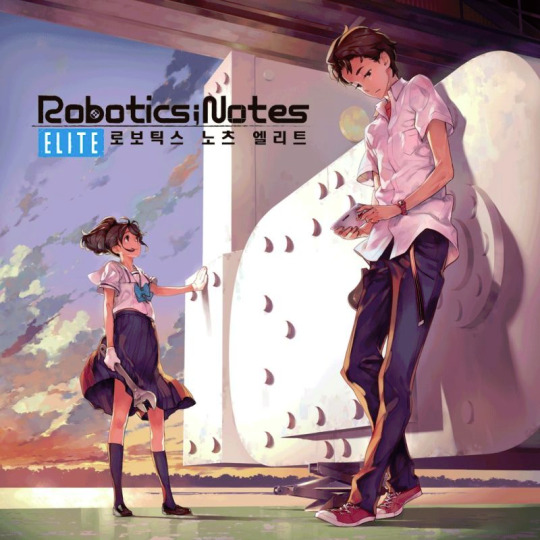
Kaito Yashio is a student of Chuo Tanegashima High, and one of the two members of its Robotics Research Club. The president of the club, Akiho Senomiya, Kaito’s friend since childhood, and little sister of the club’s founder, Misaki Senomiya, is completely committed to completing GunBuild-1, a lifesize recreation of the titular mecha from the extremely popular anime Gunvarrel, and a project the club has been working on since its creation. Unfortunately for Akiho, everything seems determined to see her efforts be in vain. The club gets no funding, and is seen as a laughingstock among the students, its advisor, Mitsuhiko “Mitchie” Nagafukada, is completely irresponsible and rarely does anything of help, and Kaito is completely apathetic to anything that isn’t KillBallad, a mobile fighting game he’s determined to become the top player in the world in. While the club soon manages to gain three new members, namely Subaru Hidaka, an expert in robotics whose knowledge far surpasses Akiho’s, Junna Daitoku, a former member of the karate club, and Kona Furugoori, aka Frau Koujiro, the teenage creator of KillBallad, their personalities are just as difficult: Subaru sees the project as a lost cause, and refuses to help with it without a compromise, Junna is painfully shy and has a fear of robots, and Frau is a complete shut in and social mess, being completely perverted and mostly talking in outdated slang, which keeps most people from even understanding her. Despite all this, Akiho’s unrelenting passion for mechas, and desire to step out of her sister’s shadow, compel her to continue on.
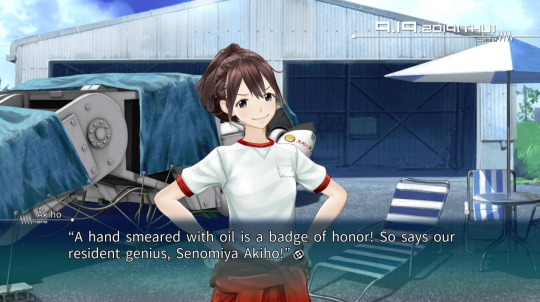
Meanwhile, Kaito one day encounters Airi, an AI that exists within the augmented reality app IRUO, along with a strange AR annotation called the Kimijima Report, authored by Airi’s deceased creator, Kou Kimijima. Within it are warnings of a grand conspiracy that aims to devastate humanity, the details of which are contained in similar reports hidden all over Tanegashima, locked behind “flags” that must be cleared before they become visible. Though at first skeptical, it soon becomes clear to Kaito that the reports contain a disturbing amount of truths, and that he’s become involved in something far larger, and far more dangerous, than he bargained for.

I’ll say it now, the story’s focus on both of these plotlines causes a number of noticeable issues, mainly due to feeling very disconnected from each other. While all of the main cast except Airi are heavily involved in the Robotics Club plot, only Kaito, Airi, and to a much lesser extent Frau are involved in the Kimijima Report plot, in comparison to, say, Steins;Gate and Chaos;Child, which tied its whole cast into their stories much better. In addition, the majority of the focus is on the club, and though always interesting, the reports tend to go rather uneventfully as well. Due to this, the story can feel very slow and meandering if you don’t know just what you’re getting into, much more so than the other entries in the series, which can definitely make it seem unappealing. Additionally, the story is much less standalone than most SciAdv VNs, where the references are often minor. Here, there are some rather significant references to Chaos;Head and, to a lesser extent, Steins;Gate, to the point of outright spoilers in a few cases, meaning going through those beforehand is heavily recommended, which is especially annoying when Chaos;Head still has no official translation, and only a fan translation for the incomplete PC version.
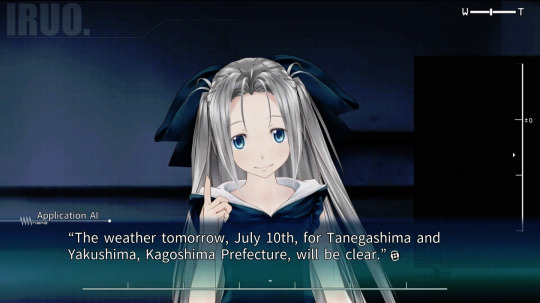
Despite all of this, both plotlines are actually quite compelling, once you get used to the game’s pacing. Robotics;Notes’ biggest strength is its absolutely great cast of characters. Everyone in the main cast is very likeable, distinctive, and well developed across the story, and have good dynamics with each other, with Kaito and Akiho’s interactions being some of the biggest highlights of the game, with the end result making everyone feel significant in their own ways, and truly feeling like a unified group, something Chaos;Head and even Steins;Gate struggled with at times. Kaito, who initially comes off as a very motivationless character, has a good amount of backstory and a constant, if subtle, arc throughout the game that makes him properly fleshed out. Subaru, who’d normally just be the token other guy, is a prominent and likeable character in his own right, having a very important role in Gunbuild’s construction, while Frau, who initially just comes off as comic relief, has many great moments throughout the story, with her focus chapter in particular being one of the best in the game. Even Airi has quite a bit more to her than it may seem. The cast is definitely a worthy successor to the cast of Steins;Gate, even more so than Chaos;Child’s, I would say.

The cast also heavily ties into one of the main themes of the game, namely dreams, the harsh difficulties and compromises one faces in pursuing their dreams, and how losing one can change a person. All of them face this, with varying amounts of focus, and it’s a theme furthered with the prominence of robots throughout the game, both the idealized kind found in mecha anime, and the real, practical robots of the real world. There’s an almost exhaustive amount of detail put into the construction and function of real robots, which makes for some interesting, if sometimes long winded, discussions throughout the game, in true SciAdv fashion.
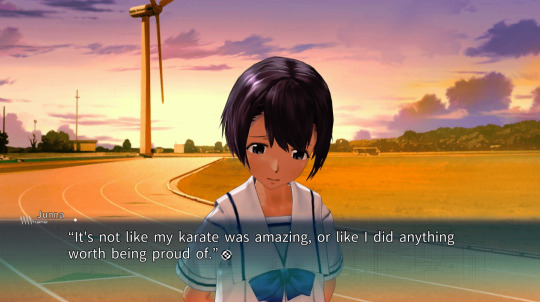
While the story is mainly told through Kaito’s perspective, it switches fairly often to other characters, most often Akiho. While the rest of the series except for Steins;Gate does this as well, it’s notable here for giving almost every character, even the supporting cast, at least one scene from their perspective, often focused on their own personal dilemmas, or flashbacks involving Misaki. These perspective switches make a nice change of pace, and definitely help flesh out the characters even further. On the subject of the supporting cast, while most other entries either have supporting casts that are very inconsequential, such as in Chaos;Child, or almost nonexistent, such as in Steins;Gate, Robotics;Notes, on the other hand, has a much more prominent and fleshed out supporting cast. From Mizuki Irei, the harsh and snarky convenience store employee, and info broker to Kaito, to Tetsuharu Fujita, the grumpy but fair “Robot Doctor”, to Mitchie, the horribly unreliable, yet entertaining club advisor, they certainly leave much more of a mark than usual. The most interesting of all, though, is a 20 year old Nae Tennouji, originally a very minor character in Steins;Gate. She has an almost surprising amount of prominence throughout the game, and even has her own ending, if a very short one.

Compared to most other entries in the series, Robotics;Notes definitely carries a much lighter tone. Tanegashima makes for a very relaxed setting, and as mentioned, there aren’t quite as many big events as one might expect. The characters are generally pretty lighthearted in personality as well, up to Kaito not being nearly as unlikeable to start off as other SciAdv protagonists. However, the tone works quite well, and helps slowly endear the characters to you even early on. And while it’s not quite as messed up as, say, Chaos;Head, it’s got more than a few disturbing elements and scenes of its own. Ultimately, it has the same “feel” as the rest of the series, and when it wants to be intense, suspenseful, sad, or whatever else, it absolutely works, especially from chapter 7 onward.
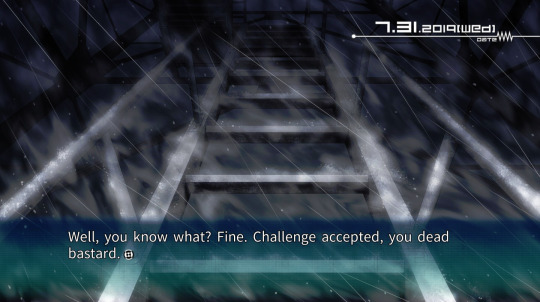
As far as “gameplay” goes, there’s a surprisingly large amount of interactivity available. At most moments during the story, Kaito can pull out his tablet and access its various apps. Most prominently, there’s Twipo, an obvious lawyer friendly version of Twitter, where Kaito can look at tweets from the Robotics Club, its associates, and even random accounts commenting on current events, with Kaito having the option to reply to those of the Robotics Club. There’s also IRUO, the augmented reality app, which lets the player look around the area and scan geotags, which contain small profiles for characters, or details for locations or objects. IRUO is also used along with a map app to search for the Kimijima Reports, letting you travel to various different locations on Tanegashima to search. It’s a neat concept, but the icons for the reports are so small, and so many locations tend to be available at one time, that finding them can often just be annoying. There’s also, of all things, the otherwise story reliant KillBallad matches, where you have to successfully input a string of buttons, the length of which varies depending on the opponent’s skill, within a time limit in order to win. Most of the time it doesn’t matter, but there are achievements and even story sequences reliant on winning or losing certain matches. All in all, these make for nice occasional changes of pace, but it’s still a visual novel in the end.
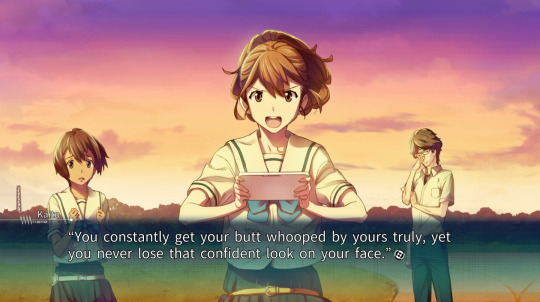
Visually, Robotics;Notes is actually quite impressive. As can be seen in the screenshots, instead of sprites, 3D character models are used instead in normal scenes, and having played Virtue’s Last Reward and Zero Time Dilemma well before this, I was more than a bit wary of them before release. Thankfully, compared to the cheap models of those two games, they’re much, much better. They’re actually very expressive, and have some great animations that give each character a lot of life. The backgrounds are also quite well done, and Tanegashima definitely makes for a unique and atmospheric setting. As usual for visual novels, there’s also CGs throughout the game, done in a different, but still appealing and well drawn style. Finally, in one of the biggest additions to Elite compared to the original version, occasionally, clips from the anime adaptation is used, mostly to better demonstrate details that were only narration originally, as far as I can tell. This blend of 3D models, CGs, and animation is a bit bizarre at first, but it works surprisingly well, and makes for one of the most visually appealing entries in the series.


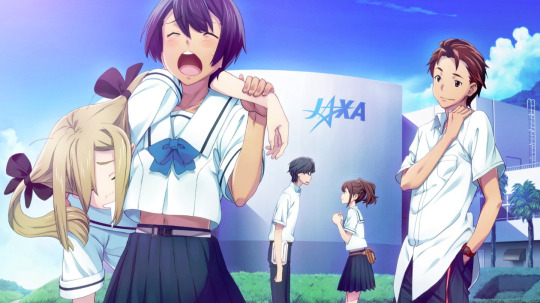

As far as sound goes, Takeshi Abo is once again the composer, and once again puts out a very good soundtrack, which further captures and enhances the atmosphere. The soundtrack in general is definitely much lighter and peaceful than usual, but actually has more tracks than most of the SciAdv soundtracks, allowing it to cover many other moods as well. From the very relaxed Winds of Tangegashima, to the mysterious Uchugaoka Park, to the nostalgic Memories with Big Sis, and especially the beautiful title screen theme, Robotics Notes -2nd theme-, there’s a lot of great songs to be found. The voice acting is also very good, and the characters wouldn’t work nearly as well without it, with Ryohei Kimura as Kaito, Yoshino Nanjo as Akiho, Kaori Nazuka as Frau, and Sora Tokui as Junna especially sticking out to me.
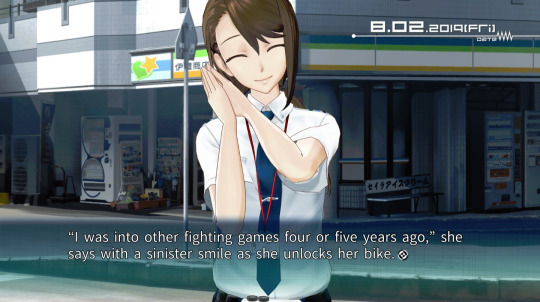
It’s worth noting that Robotics;Notes is on the longer side when it comes to SciAdv, much like Chaos;Child. It’s hardly Fate/Stay Night, but it’ll take some time to get through. It also has a very, very weird and annoying ending system. Whereas in other titles, endings are, just that, actual endings you can diverge into somewhere in the story, Robotics;Notes’ endings are actually just regular chapters that are part of the main story, which just happen to focus on different parts of the cast. The divergence happens in chapter 5, and depends on your replies to said characters on Twipo in both that chapter and the preceding one, with you instead going to the short Nae ending if you don’t fulfill the requirements for any of them. While Steins;Gate had a similar system, and was annoying in of itself, Robotics;Notes takes it to another level by making all but the Nae ending mandatory, though said ending has some points that make it worth seeing regardless, and occurring in a specific chronological order, despite allowing you to get the endings nonlinearly, meaning you could accidentally skip from chapter 5 to chapter 8. The system overall is just unneeded, and following a guide, such as the one by the aforementioned Committee of Zero, is highly recommended.
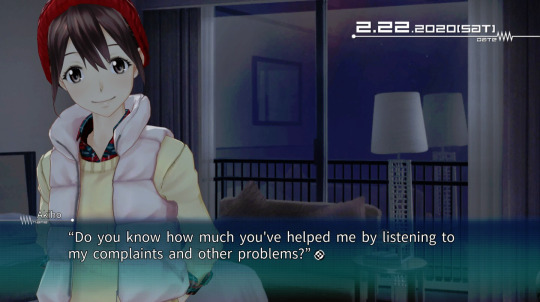
In the end, would I recommend Robotics;Notes? To a SciAdv fan, absolutely. To someone who isn’t, well, I already explained the problems there. I can’t say its one of my favorites among the series, but by itself, it’s still something I enjoyed a lot. Despite the issues it does have, its very well done cast, visuals, sound, and overall story make it a memorable and emotional experience in its own right.
Now, with yet another long VN review out of the way, I anxiously await the Committee of Zero patch for Robotics;Notes DaSH, to finally finish off my SciAdv journey, for the foreseeable future, at least. Till next time.
-Scout
31 notes
·
View notes
Text
Pokemon Prism Review
Well I’m currently finishing up the post-game content of Pokemon Prism.
Dang.
What a fun game.
(what follows is an informal review of the game. it got a little long, lol. it has some spoilers for the game, of course.)
My background
To give you a quick idea on my perspective on Pokemon, I grew up with Pokemon Red on the big grey brick Gameboy. After Red, I pretty much stopped playing for many years. My little brother had a Gameboy Color and had Silver, but I never got one myself. Wasn’t ‘til years and years later I found some emulators and played through several generations of Pokemon at once. So, Gen 2 really isn’t nostalgic for me. It’s close enough to Gen 1 to hit some nostalgia buttons, though. I am admittedly somebody who feels Gen 1 is the best gen of pokemon. I don’t care of people laugh or say I’m a genwunner for believing that. Gen 1, I feel, had the raw creativity and charm of the original idea, and it simply sets my imagination alight far more than any other gen does. Those simple pixel designs for those little virtual creatures just opened up a world in my mind. THAT SAID, I did play and very much enjoyed all the other gens of pokemon. I do not shun things just because they are new, and I am not one of those people who says the new designs of pokemon are stupid. I adore plenty of modern pokes.
Blend of Old and New
Anyway! Pokemon Prism, for those unaware, is a ROM hack of Pokemon Crystal. It essentially delivers a brand-new Pokemon adventure for the Generation 2 games. It’s a really neat blend of classic gameplay and modern features. You’ll find species from modern games all the way from Gen 3 (such as Breloom) to Gen 6 (such as Sylveon) but their sprites perfectly integrate them organically into the Gen 2 environment. You’ll get many modern pokemon moves and conviences but also plenty of throwbacks to older experiences. Miss crafting pokeballs from Apricorns? It’s there. Enjoy a simplier time when there weren’t any Natures? Well, there ya go. Really want to call Joey and talk to him about his Rattata? Well, err, no, you can’t do that, but let’s face it, the telephone feature was probably one of the most hated features in Gen 2. :P
But Prism isn’t simply about updating Gen 2 with some modern pokemon, moves and game features. Not in the slightest. It’s full of original mechanics and gameplay concepts, and has tons of original areas and an original storyline. Pokemon is known for experimenting with new gameplay ideas, so it’s really fitting and enjoyable to see these take shape as you play the game. Mining and crafting is introduced in the game, for example, and there are a couple new pokemon types. There’s even a few sections where you can play as your pokemon, Mystery-Dungeon style. Do all of these experiments with new concepts work? Probably not ALL of them– when you try something new, not all of them will work out as amazing as you’d hope. But a lot of them are welcome and fun additions. And the game is bristling with these new ideas! It’s a joy to see so much creativity and novelty.
Sprites
It should be noted the spritework for these games is A+ and utterly fantastic. There is perhaps 3 or 4 out of dozens and dozens of new sprites that I thought were a tad off? Seriously, they look AMAZING and their animations are perfect and they fit in with the style so well I found myself briefly getting confused as to which were originally from Gen 2 and which weren’t. Saying these sprites are good is no small thing, because they are such a vital part of the game. The backsprites were not shafted, either– something even Gamefreak often shortchanged on back then.
Music
It should also be noted the music in this game is really damn good and has a huge variety. There are tons of classic songs, classic remakes of modern pokemon songs, remixes, and original tunes. There were like one or two tunes I was a bit iffy on, but considering that’s only a few out of so many, that’s impressive. The new bike music and Surfing music are probably my favorites, and they are SO GOOD, and those are especially important ones to sound good, because you typically hear those a lot.
Writing
The writing in this game is fairly solid. Not A+, but still not bad. It suffers occasionally from slightly rough and confusing grammar, and the climax of the story is definitely anti-climactic and very weak. In addition, the post-game story basically does not exist, but that can be excused since most likely more story was planned but they ran out of time. (C&D)
I also felt that at times, the story felt out-of-place within the world of Pokemon and went “too far” in the darker direction. The entire prison sequence, especially, and the frequent mention of inmates being mistreated, pokemon being abused, etc., just felt a bit much. Because this game was largely concerned with replicating the feeling of a true Pokemon game (some hacks intentionally focus on making a story that would never take place in the Pokemon world, like zombie survival horror stories or whatnot), I find it relevant to mention that. All of that said, though, its darker departures were at least not *too* extreme. We don’t get the very jarring and frequent problem of some ROM hacks where it’s full of cussing all the time or intense violence. Compared to those it’s still relatively subtle. And while the NPCs in this game I felt were rude a little too often, (holy crap, it felt like 95% of Naljo and Rijon were crankyass people) I do appreciate the attempts at making people a little more “real” and not quite so freaking happy and idealized all the time like Nintendo tends to do. The dialogue often made me chuckle. It did go a tad overboard with that “realness” (because, hey, a variety of people exist in the world, you know, both rude and polite, optimistic and bitter) but oh well.
So yes, the writing had its drawbacks. But overall, it felt like it was progressing a pokemon-style narrative with some interesting ideas, and wasn’t simply a dreary rehash of the same basic tropes Pokemon has been regurgitating for ages now. I just think if the writing were cleaned up a bit– the grammar cleaned up in a few sections, the plot threads clarified a bit more, and the climax reworked– it could take a “decent story” and make it a great one. There’s definitely some neat ideas there, it just needs polish.
Maps
As to the different towns and locations in this game to explore, there are many. This game is ambitious AF. As I said, it’s FULL of new ideas, features, things to do, and places to explore. Naljo is the region you explore in the main game, but post-game you can wander a whole new region of Rijon (the featured location of an older ROM hack, Pokemon Brown) and beat all the gyms there. In addition, there’s a few towns in Kanto and Johto you can visit (I believe they originally planned to open up all of those regions eventually), AND one town in ANOTHER new region, Tunod. The game’s ambitiousness occasionally outpaces what it delivers, but that’s quite acceptable in my mind, since updates with additions to the game were originally planned. So, yes, there isn’t much to do post-game, but that’s largely because a lot of stuff was going to be added.
Back to the locations, though! It’s an important aspect of ROM hacks. Not everyone is good at designing a good town, with logical building placement, intuitive layouts, aesthetically pleasing locations, and interesting things to explore so it doesn’t feel totally plain and lacks character. I’m pleased to say this game does a great job of it, though. I should point out I have a terrible sense of direction and bad spatial memory. Despite that fact, I found myself remembering important features and where they were located– oh, the Move Deleter house is in Phacelia on the left, the bullet train is in Torenia– and that’s a good sign. Physical travel was not a sloggy chore, and it wasn’t bogged down in a confusing layout. Towns were memorable and fun to explore.
Pacing/Level Curve
Another thing ROM hacks can screw up, because it’s a tricky thing to do, is the challenge pacing. How many trainers? What teams do they have? What levels? Are the Gyms challenging without being insane? I actually Nuzlocked the main part of the game. In my opinion it was well-paced. There’s probably fewer trainers overall in this game than a standard Pokemon game. But it did not take me much extra grinding in the grass– and I was only doing that to play it safe for the Nuzlocke. And that’s GOOD. You shouldn’t have to do tons of grinding in the grass all the time just to have a reasonable shot at the gyms. Pokemon Uranium, sadly, seems to suffer from that issue. So, yeah, the pacing was very reasonable to me, good balance of fair and challenging.
… with one important note. Once you reach the League? Well, we could have used higher-levelled wild pokemon in the cave that served as the victory road. The highest in that cave was level 34 or so, and you were facing trainers with teams ~level 55. That’s a huge gap. Not everyone has the same play style. Some people like to do extra grinding before the Elites. Some people are Nuzlocking and may do extra grinding as a safety buffer. Some people might want to adjust their team & add a new pokemon to their team and need to grind them up from a lower level. For those cases, you NEED decently-levelled wild pokemon to grind on. So, yeah, I really do think the Seneca Caves wild pokemon need a level buff. It would also help with the level gap for the post-game. Trainers in Rijon are suddenly at levels 70ish and higher, and for some folks playing, that’s a bit much and they’d like to do a little grinding first.
Puzzles
This game has puzzles. You have been warned, lol. Apparently a lot of people found the number of puzzles a bit frustrating, or felt that some of them were excessively tricky or annoying. I find it very funny, because usually puzzles are my least favorite part of a pokemon game. But I really enjoyed the puzzles in Prism and didn’t find it annoying or offputting at all. I was sick with a cold through most of my play of Prism, and yet even in my dumb brainaddled state, I didn’t find the puzzles too difficult. I solved them all at a pretty average length of time, even the ones some people traditionally found a little unclear or confusing. (the Ruins puzzle often confuses folks, apparently, but I really didn’t have a problem with it at all.) I was briefly confused on one of the switch puzzles (and it contained an element of bad puzzle design imo– there’s a gap that you can leap down into when normally a gap of that size just gives the ‘run into wall’ sound and is not passable) but not for too long. Even the ice slide puzzles, which I traditionally hate with a passion, were not bad!
All except for one thing. The Magikarp Puzzle. Anyone who has played Prism knows what I mean. Haha, fuck that puzzle man. Even the creator of the ROM hack himself has acknowledged the puzzle was not great, heh. To be honest, I find it kind of hilarious, in a way, though. I mean, obviously it’s a nightmarishly difficult and frustrating puzzle and is intensely exhausting to look at, let alone try to solve. But it’s also kinda glorious in its demonicness. I didn’t spend too much time on it before just looking up a solution to it. It’s tedious and not fun at all, and hey, that’s OK, because even the creator realized that.
pls nerf magikarp
But seriously, outside of the magikarp puzzle, I didn’t just enjoy the puzzles in this game– I felt like they were an important part of what gave this game its character.
Fakemon
There are even a few fakemon in this game! Which I was excited to learn because I thought there weren’t! All of the fakemon are Legenderies. Unfortunately, I don’t care for most of their designs. Like, at all. I think Varaneous and Libabeel’s sprites look really, really shitty. They’re ugly and don’t match the style of Pokemon at all. This feels weird to say, since I love so much about this game, but man, there’s just no way around it, I hate ‘em. Everyone has their own tastes, of course. There’s a couple fakemon I have yet to capture– I’m finishing that up now and the very very last of the post-game. But one fakemon I did capture and ADORE LIKE NO OTHER is Phancero.
I happen to know about Phancero’s designer, because I saw their design years ago. They apparently were approached by the team and were asked permission for the use of the design, which is awesome. I won’t rant again about Phancero here because I already ranted about it before, and literally could keep ranting for pages. :P But yeah, it’s a totally creative and awesome pokemon both in idea and execution, and by FAR my favorite fakemon ever created.
Conclusion
This is the best ROM hack I have played in years and probably ever. I haven’t played hundreds of ROM hacks, but I have probably played dozens over the years. I think they are a creative and wonderful expression of the pokemon community, but let’s be honest. There’s a lot of really bad ROM hacks out there. There’s even more ROM hacks that have a lot of potential but are never finished or anywhere near completion. (And that’s perfectly understandable. People run out of time, they have real life get in the way, etc.) The fact that not only did a ROM hack of this caliber get made, but was 95-99% completed? Is fantastic. It was an intensely massive project and I cannot begin to imagine how much work it must have been. Pokemon games are normally developed by an entire team at a company, and folks are paid to do it. The comparatively small team of devs who made this game in their spare time and implemented these amazing things had to do it all on their own. It’s no wonder it took as long as it did for them to finish it; and the amount of effort SHOWS. There is so much loving attention to detail and polish to Prism. (I mean, yes, there’s still some bugs and the occasional unfinished bits, but of course there are, those were going to be finished, but then the C&D hit)
Most ROM hacks are just strong in a few areas, because it’s one or two people who have strengths or interests in a few things. So, you’ll play a hack with a really good story but terrible fakemon and mapping, or you’ll play a hack with fantastic designs of new areas, but no new story, etc. Prism kinda has everything, though. It really did feel like playing a new Gen 2 game.
(It’s now almost 11pm and oh god where did the time go. I have a problem with being concise. :P This was far longer than I intended but thank you if you’ve read this far!)
This is a repost on a new blog. The original post was on Jan 17, 2017.
8 notes
·
View notes
Photo
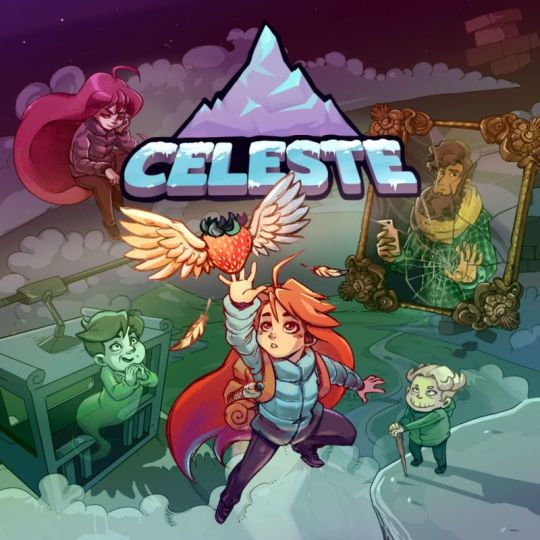
The Real Mountain Was the Friends We Made Along the Way - A Celeste Review
Genre: Adventure
Subgenre: 2D Platformer
Developer: Matt Makes Games
Publisher: Matt Makes Games
Platform(s): PC, Switch, PS4 (Reviewed on Switch)
Release Date: January 25th, 2018
Celeste is a game that completely took me by surprise. I first saw it while idly browsing through the Switch eShop back in 2018, and after checking out the trailer and seeing a bit of mention of it online, decided to give it a try. I was distinctly impressed by its tight controls, touching story, and wealth of challenging-but-fair gameplay. Now, a little over two years later, I decided to revisit the game and see if it still holds up.
Story
Celeste focuses on the story of Madeline, a young woman who decides to climb Celeste Mountain in an act of defiant self-exploration. Along the way, she’ll have to face her insecurities and anxiety head-on in the form of a ghostly doppelganger created from her negative emotions that seems to haunt her at every turn. Despite this, she is rarely alone, as she has the company of fellow climber Theo, a selfie-loving hipster; a kooky old woman who lives on the mountain; and more. Each character has their own troubles and reasons for being on the mountain, though Theo is vastly more fleshed-out than the other side characters.
While the story is never tear-jerking at any point, it definitely hits home with a young adult such as myself who is also dealing with similar insecurities as Madeline, and has a good message about learning to rely on those around you, and to accept yourself for good and bad. I really enjoyed that the game is not afraid to touch on very real aspects of mental illness in a way that neither glorifies nor diminishes it, and treats Madeline as a real person who is just doing her best to work though her issues, making both progress and mistakes along the way.
Gameplay
At its core, Celeste is a 2D platformer that focuses on challenging-but-fair levels. Each chapter of the game is its own level, broken down into rooms that you progress through in a roughly linear format (with minor sidetracking for collectables), ultimately trying to reach the end. Madeline has a number of standard platforming moves, including jumps and wall jumping, but with expanded mechanics such as the ability to climb walls and dash in midair. While these mechanics are very powerful in theory, they’re well limited. Madeline only has so much stamina for climbing, and when it runs out, she begins to slide down the wall. The dash mechanic is also limited to one use, which is recharged upon landing, hitting a spring or other object, or touching a crystal pickup. I really liked how well-balanced these mechanics felt, as even if you’re out of stamina, you can still wall jump to attempt to save yourself, and there are plenty of ways to replenish both stamina and dashes.
Each chapter of the game also introduces its own mechanical gimmicks that interact with Madeline’s core mechanics in some way. Most of these end up being variations of moving platforms, but there’s enough variety to keep things fresh. The game is also very good at teaching you not only how these gimmicks work, but how you’re expected to synergize them with your core movement.
The game even has advanced techniques for speedrunners and other expert players, such as what I refer to as the wavedash, where you dash diagonally down into the ground and jump a split second later to preserve the forward momentum of the dash, while keeping your dash charge from being on the ground. Advanced players will find all sorts of advanced tech and applications for them that will allow them to finesse their way through the game’s levels and find hidden skips.
The game also has a few optional collectibles. First are the strawberries, which are the main collectibles. There are around 20 strawberries per chapter, and most are either located in out-of-the-way challenge rooms, tricky locations on the main path, or hidden in secret holes in the map. One thing I liked about the strawberries is that it usually isn’t enough to just get to the strawberry, you also have to make your way back to solid ground afterward. You also aren’t pressured to collect them if you don’t want to, and the game even says on a loading screen that they’re purely optional and to only go for them if you want to. I found most strawberries to be fair enough to collect, though there were the odd one or two that were frustrating to find, as they required the player to spot tiny irregularities in the level design to investigate.
Aside from strawberries, each chapter also has a hidden Cassette Tape that unlocks a more difficult B-Side chapter that remixes the themes and gimmicks into a much harder version. The B-Sides were definitely more stressful at times, but felt really good to get through. If I were to do another playthrough, I’d probably want to revisit the B-Sides after doing all the main chapters, as the alternating spikes in difficulty made the difficulty curve more on the stressful side.
Lastly, each chapter has a Crystal Heart collectible that is usually extremely hidden, but allows unlocking end-game content. Like some of the strawberries, a few of the Crystal Hearts can be frustrating to find, and a few are further hidden behind puzzles that the player has to solve based on very limited information. I enjoy puzzles like this in games, though later on in the game they can start to border on obtuse.
Celeste also comes with an extremely well-developed Assist Mode that lets the player fully customize how the game runs, including slowing down the game, allowing infinite stamina or dashes, etc. Though I never used it, it’s not only a great tool for less experienced players to get through a challenging game, but it’s also useful for those who want to fully explore everything the game has to offer and test the limits of the engine. Unlike other games that rub their assist modes in the player’s face, Celeste never nags you about it, but always has the option ready in the pause menu should you need it. This allows the player to switch in and out of the mode at will without feeling like the game is forcing them to. Nintendo could really learn a lesson from Celeste.
There’s also a plethora of end-game content that I won’t go into here, but suffice to say that there is plenty to do in the game after the credits roll, including a free update to the game that added an additional postgame chapter.
My only real criticism of the game is that levels have an obnoxious tendency to block access to previous rooms without warning. This is particularly frustrating when you notice an alternate path or potential secret just as you go through a room transition and there’s no way back into the previous room. Though to be fair, once you’ve completed a chapter, you can start from any of the chapter’s main sections. Plus, the game tells you which collectibles you’re missing in each area, and once you’ve obtained a collectible, it’s immediately saved, so if you’re only missing a few strawberries, you can easily jump into the section where you’re missing them, grab them quickly, and then exit the level. Still, I think it would be worthwhile if the game had some way of letting players know that certain doors will lock behind them, or otherwise indicate that certain paths are one-way only.
Presentation
Celeste’s visuals use a pixel art aesthetic with tons of detail, making each room of each chapter a delight to the eyes. Each chapter is also visually distinct enough that you always feel like you’re seeing something new. One interesting point is that the game seems to be using a feature that can dynamically stretch and squish sprites without requiring the developers to draw individual frames for these transformations. This is a pretty ingenious idea, though I felt at times it was a bit too obvious, as some of the results could be a bit jagged or exaggerated. Still, it’s probably not something that the average player would notice or care about.
The game’s soundtrack tends to focus on relaxing background pieces that set the mood with lots of emotional piano parts, but also knows how to build up energy during high-tension sections or make the player feel triumphant. Additionally, each B-Side chapter has a remix of the chapter’s theme, which adds additional pizzaz to the soundtrack.
Conclusion
Celeste is an amazing game that bleeds charm and love from the developers, and will leave you feeling accomplished and hopeful. It has enough challenge for platforming veterans without being unfair or inaccessible to less experienced players. There’s something to love here for everyone, and I urge everyone who is even slightly interested in the game to give it a shot.
Score: 9 / 10
6 notes
·
View notes
Text
Design of Doom Eternal
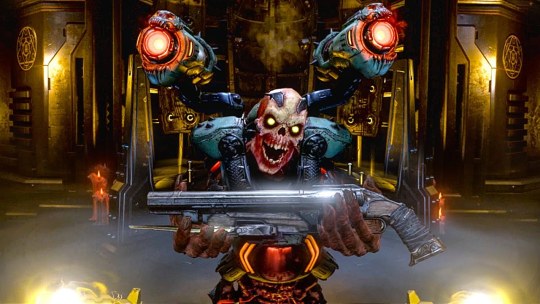
Wanted to jot down some thoughts while they were still fresh, and I hate writing threads on Twitter, so, here we are.
(Surprise! Male game designer has DOOM OPINIONS. BEHOLD LOL)
First, disclaimers: what follows is super subjective, pretty picky, and likely unjustified. I love a good mobility shooter - Doom 2016 and Titanfall 2 are the only western shooters I really enjoy, and each do super interesting things spatially, mechanically, etc. However, I’ve never worked on any kind of FPS type of game, and never worked on a AAA game, nor shipped a game during a global pandemic, and there’s a lot that I don’t understand about what goes into making this kind of thing, much less how it’s even possible. Making a followup to a well-loved and hugely successful game is also a terrifying prospect. Finally, I am about to "dwell” on what I perceive to be “negative” things about the game, which is pretty unfair, because there’s a LOT of positives (it’s fun, it’s gorgeous, the load times are crazy short, the vistas slay again, amazing accessibility options, perfect audio, etc etc). But I think this is a game where a lot of the positives are really in your face, and what again I personally perceive to be the negatives are a little bit harder to put your finger on. And this isn’t a review, and definitely isn’t yucking anyone’s yums. This is me trying to figure out why this one feels a bit different to play. Hopefully the unanimously positive reception of the game by literally everyone everywhere (including myself) balances out whatever acid might be in these queries.
OK!
Jungle Gyms Versus Canyons
Ok, so. Doom Eternal is structured a lot like 2016 in that it’s corridors linking big wave-based arenas, which is a good structure for a game about shooting all the things. Arenas can be flat-ish or tall-ish. Tall-ish arenas seem to roughly come in two flavors: jungle gyms, and canyons. Jungle gym arenas are the ones that I feel like took centerstage in the marketing and gameplay of Doom 2016, as a way of showing off the double-jump / ledge grab / launchpad vertical mobility stuff, and because they make narrative / thematic sense in the human-built oil rig environments that comprise much of Doom 2016′s level architecture. Jungle gyms are distinguished somewhat from canyons by generally having what feel like distinct “floors”, or solid planes creating multiple separated levels of combat. Canyons, even if they have some transverse traversal elements, are more open and chaotic, with less concrete divisions between elevations. I’m belaboring this essential difference because it has a bunch of second-order effects on gameplay - jungle gyms allow you to jump from skirmish to skirmish, you can use your mobility options to “interrupt” combat, while canyons are more continuous. Jungle gyms usually have more obstacles (like the aforementioned distinct floors) which make it slightly harder for long range enemy attacks to land, which reduces the overall ambient damage-soak.

The key thing about all these arenas - flat open spaces, distinct jungle gym environments, and canyon style playgrounds - is that you definitely want all of them in your game, because the strategy and tactics for playing these fights changes a lot based on these constraints. When do you want a roof over your head? When do you not? When do you want your back to a wall? These are valid and important differences for these games specifically, especially when basic resource management strategies in these encounters is pretty similar, and because the enemy behaviors and attacks have so much variety.
So far, though, Doom Eternal feels like it has a WHOLE LOT of canyons, and NOT a whole lot of jungle gyms. It’s possible that this changes later in the game, so take all this with a big grain of salt. But the first 3-4 hours of gameplay are really dominated by canyon-style vertical arenas, which isn’t necessarily ideal in terms of variety (and makes you angst a little harder for the wall-run affordances of other mobility shooters). They also tend to be slightly same-y, outdoor, rocky environments, versus the more oil rig-inspired, recognizably human-scale mining structures of 2016 (I’m sure this changes later in the game too). The oil rig-inspired stuff also lends itself to jungle gyms a lot more naturally, so I feel like these choices of arena shapes and environment types are kind of an interconnected and difficult problem.
None of this would really even qualify as a problem, either - this is nitpicking nitpicks, at this point - except relying on canyons so much exacerbates some of the “fussiness” of the combat changes (those are next). For me, anyways - I’m not sure anyone else is feeling like these are problems haha. And it’s a big game, so I’m not sure how much this stuff changes across the whole campaign yet!
Tactical Ballistics
A Doom thing I adored in 2016 and am continuing to enjoy in Eternal is the way ammo, health, and other arcade-style upgrades are thoughtfully placed around the arenas. It’s a nod to the strongest parts of Vanquish’s level design, and goes all the way back to using coins in Super Mario to lure players out to new places they might not explore otherwise. It’s a huge part of what gives the nu-Doom arenas their “chess-like” feel, and shifts the fights away from Serious Sam-style battles and makes them into four-dimensional puzzles. 2016 doubles down on this tactical approach by leveraging a kind of resource triangle of chainsaw kills, glory kills, and just plain firefights.
A lot of Eternal’s design seems committed to upping the ante on all of these strengths. Lower ammo capacities puts more pressure on the chainsaw kills. There’s a new technique called “flame belch” that turns the resource triangle into a resource square to accommodate armor. Monsters have “weak points” now, shortcuts that change their behavior or get you fast glory kills. It’s a pretty compelling jigsaw puzzle of abilities.
It also places a lot of strain on player attention and cognition, because all this is running on top of straight-up arena-wave firefights (with 7+ enemy types at a time, all with unique behaviors and optimal strats) AND beefy mobility controls (swinging, dashing, double-jumps, ledge grabs, launch pads, etc). It’s kind of a lot. But I don’t think this is necessarily the place for saying “this is DOOM, man, you got to keep it simple, just shoot the monsters, how come there’s even upgrades” or whatever. For so many reasons, but the primary of which is that most of this stuff rules, and throwing it away would suck. So what do you do?
I want to focus on two small, specific things that really stand out to me - I’m not totally sure that they’re actually “bad”, but I think they have a lot of weird secondary and tertiary effects that contribute to some perceptions of “fussiness” in some of the battles.
Weak Points
This is a big enough change that it is repeatedly tutorialized through video on every loading screen, after every game over, and after every new enemy is introduced... so I know it was on the designers’ radar haha. And it's an interesting addition - chess fights in Doom are already about hierarchies, and adding another tiny hierarchy within an existing hierarchy is a NICE bit of tension to add, it gives a kind of scrambly feeling that is good overall. The issue for me arises from an apparent or perceived damage scaling issue around these weak points. For example, the optional sniper rifle upgrade to the heavy cannon and the optional sticky bombs upgrade to the shotgun insta-wreck the arachnotron and revenant enemies’ weak points, while sustained plasma rifle fire doesn’t seem to ever do the job. Which makes sense on paper - this is a nice way of putting pressure on the player’s weapon choices and ammo, which is what it’s all about. Although I guess you could argue that it’s also all about movement, and that this particular combat pressure has a pretty tenuous relationship with mobility in general.
Either way, it means you spend a lot of time squinting at your weapon wheel mid-battle to see how many shots your shotgun still has, because you ran out of chainsaw fuel a while ago, and are still being actively bombarded at a pretty long distance (because its a canyon and not a jungle gym). I know, I need to git gud, trust me, i KNOW. But check out the weapon wheel ammo display size in Doom 2016 versus Doom Eternal:

I love the new color scheme and ammo icons in Eternal! But it’s 3-4x harder to read the actual, very important ammo counts.
All these small changes add up to something that feels like a pretty different gameplay experience compared to the more spatial (read: movement-based) and literally easier-to-read resource management stuff from 2016. Which, it’s a sequel - failing to sufficiently differentiate it is its own huge risk. And, to be fair, 2016 had its fair share of fussy (though more legible) weapon switching. But when you add this stuff up, the matrix of considerations in moment-to-moment combat in Eternal is pretty different from 2016, and I think it largely comes down to the damage scaling around the weak points. While you can technically choose to play through battles without leveraging weakpoints (thus sidestepping most of these cascading issues), this approach is heavily incentivized by the major behavior changes that happen after you hit weak points (in addition to the constant tutorializing) and the waves appear to have been balanced around taking advantage of these things. Whether or not these are even flaws, technically, whatever they are is exacerbated by the UI design of the weapon wheel AND the relatively popularity of the relatively unobscured canyon arenas. So it’s hard for me to judge weak point damage scaling in a vacuum.
Overall, these new combat options make the arenas feel more constrained and more prescribed. Design is a nightmare this way: sometimes by giving people more choices, you’re actually giving them less. My pitch for a small tweak that might engage with some of these issues would be to keep weak points, but get rid of the damage scaling and maybe make the hitboxes a little bigger. The goal here is NOT to make weak point enemies easier so much as to open up options about what weapons you can use against them, thereby reducing wheel squinting, thereby freeing up more attention to movement and all the other stuff that ruuuules about nu-Doom in general.
Also, I should clarify that it’s entirely possible that I completely imagined the weak point damage scaling, and am a big dummy with bad aim.
Flame Belch
This is a pretty small thing, there’s this new “flame belch” move, intended to complement the existing chainsaw and glory kill moves as a way of “farming” resources from combat, one of the things that really defined Doom 2016. It differs in one huge way though, in that it has to be committed to BEFORE killing a monster. Chainsaws and glory kills ARE kills. Flame belch adds a status instead, which is “cashed in” later when you do the kill. If chainsaw kills and glory kills and BFG shots are Super Mario jumps, Flame Belch is more like a Tony Hawk jump - it starts early and is carefully calculated. Which is pretty dope!! But in this environment where weak point damage scaling and canyon layouts are already putting huge strains on the player’s attention, it feels like a big ask. The “triangle button” mechanic from 2016, the BFG, was a kill move with cool-down, so really I’m just suggesting stuff they already tried anyways. There’s no way this is news to anybody, much less the developers haha.
But... I would love to play a build where flame belch was totally a thing, just it was a finishing move, not a status thing. Let it plug into that reload-replacing resource-farming punctuation pacing flow. That shit rules.
Of course, I have to wonder what the unintended secondary and tertiary consequences of these suggestions would be. Good action games are often tenuous and deeply interconnected things where results are really hard to predict. Maybe they already tried these ideas and they sucked, or they know their own game a lot better than I do, and have a big stack of reasons this stuff would suck for most of their player base.
But wait...
Where The Hell Am I?
Last section, I promise.
I am extremely not going to weigh in on whether or not Doom games need “Story” or not, or what that even means.
But...
If you are driving a monster truck, it is probably pretty fun to see a big line of cars in front of you, and know that you are about to drive all over those cars, and that at the end is a really big fancy car... and you are going to drive over that too.
The general conceit of Doom 2016, that you are on one end of a Mars base, and you need to get to the other end, and in between is a whole lot of cars demons, is a good one. It has good monster truck-ness.
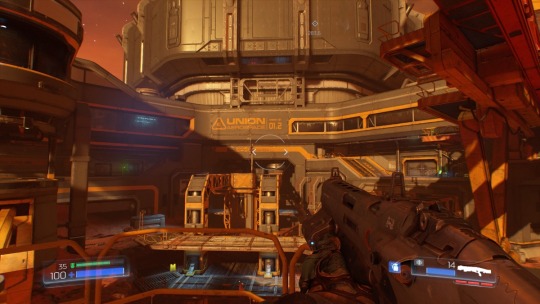
So far this is something that I’m struggling to extract from Eternal. I’m not really sure who any of these grumpy folks are, or where it is that they are, or why I am going down this corridor (aside from the very Doom-like fact that it is the only corridor around).
The problem for me is decidedly NOT that I don’t understand the slayer’s emotional whatever, or that I haven’t been painstakingly expositioned into the specific hierarchies of the demon universe, or anything that I think would normally be described as a “narrative”. For me, it’s that I don’t get to sort of soak in the anticipation of the loooong line of cars I’m about to crunch.
Does Doom need a story? Idk. Doom might need a lot of about-to-get-crushed cars though.
Finally finally finally, and this is highly subjective, but I think the slayer is just more fun when he’s an X factor or a rogue agent. NPCs recognizing the slayer feels sort of weird to me? The feeling that he is a fly in the ointment I think is stronger and sexier when he’s like... outside the canon, almost. I’m not totally convinced that having him Kratos around is as fun as having a bunch of demons and priests both confused and terrified of what this dude is doing.
OK
I need to get back to family stuff. They let me sit here and type this out, which was very kind of them. Only five tantrums so far. Either way, I’m looking very forward to playing more Doom Eternal...
...just as soon as I finish designing 17 more shirts in ACNH.
Hope everyone’s staying home and staying safe! Rip and tear, friends. Rip and tear <3
4 notes
·
View notes
Text
Final Fantasy Demo Review: Exactly What I Wanted

I never owned Final Fantasy 7 on the PS1. My first experience with the game proper was on the PS1 classics section of the PS Vita many years after its release. What I did play, however, was a spinoff game called Final Fantasy 7: Crisis Core on the PSP. The game was meant to be a prequel of sorts, detailing the adventures of Zack Fair, the owner of the Buster Sword before Cloud, and the connections between him, his superior Angeal, and Sephiroth, the main antagonist of FF7, during his time in and out of the Soldier program. The game was one of my favorites in the system, mostly because they chose to remove the usual turn-based combat into something more action oriented, with attacks, dodging and evading done in real time. It also had almost realistic graphics on a portable system in 2008, which was unprecedented and was awe-inspiring for me as a young teen. This was also huge departure from the blocky graphics that the original Final Fantasy 7 game that release a decade prior. While many thought this game was an incredible part of the FF7 story, many people wished that the original game was given the same treatment. This brings me to the demo for the new remake of Final Fantasy 7.

Look at this lovable stud.
I was skeptical about the Final Fantasy 7 remake for several reasons. The first is that it has been 5 years since the game was formally announced at E3 in 2015. Since then, there was little news about the game except a few mentions in 2018 This usually indicates issues with development and tends to temper fans expectations. Also, they announced fairly early on that the full game would not be available during the release and instead it would be a quasi-episodic game, in which the full game would be released over several games. This is also worrying because it is not known where the cuts will be and how much content will be in the game at launch, despite it being a full priced game. However, after the demo, which covers the first mission, I was completely sold on the game.

Yeah I think he looks a little better.
The game looks even more graphically amazing than most games of the same scale, with the initial shots of Aerith, Cloud, and Barrett looking near photorealistic. The gameplay is fairly similar to Crisis Core and Kingdom Hearts: there’s a button for attack, dodging and blocking while special attacks and spells are in a menu with shortcut keys for easy access. This means that the more RPG elements, like turn based combat have been removed for a more simplistic, yet engaging experience. However, that doesn’t mean that there isn’t a level of complexity to it. Characters in the party could be controlled and switched to at will or given commands for special moves and spells remotely. This meant a lot more to pay attention to at the same time while also doing your usual hack and slash fun. I often found myself struggling to get the hang of paying attention to everyone’s health and their attack skills while making sure I was staying alive and doing the right type of damage at the same time, but despite that, I never seemed to overwhelmed. The flow of gameplay seemed to be much more linear and focused, with straight pathways and enemies showing up at designated points. This does allow for there to be more focus on the story elements of the game, but I wonder what that means for levelling characters, especially new ones that join the party. The story seems to be a faithful recreation so far and the voice acting allows for a lot more emotion to be conveyed through the characters. All in all, the game plays fantastically well and the graphics and story cause the game to feel like an entirely new experience for new players and veterans alike. I still wonder about the length of the game, but the creators have said that the game will still feel like a cohesive story, even if it is not the full game. I think that this game will do what most said would be impossible: give a remake to one of gaming’s most love titles that doesn’t disappoint the incredible hype of the fanhood.
2 notes
·
View notes
Note
Do you have any recommendations for video games that are like Stardew Valley or Harvest Moon? My favorite parts are farming, mining, upgrading stuff, and befriending NPCs. Thank you! :)
There isn’t a lot out there that does it better than Stardew Valley; I personally don’t care for it due to its poor internal documentation (it’s a pet peeve!), but in terms of its mechanics it’s pretty top notch.
So rather than give you a bunch of recs for games that are basically “Stardew Valley, except not quite as good”, I’m going to hit some current and upcoming titles that are in the same ballpark premise-wise, but take the specifics of the gameplay in a variety of different directions. Here we go!
Deiland - A cross between the farming-sim and planet-sim genres, this one casts you as the ruler of your own tiny world to shape as you see fit. Not a great deal of NPC interaction, since you’re your planet’s sole inhabitant, though folks from neighbouring planets will visit from time to time. Directly inspired by The Little Prince, as if it wasn’t obvious!
Kynseed (early access) - Similar on the surface to Stardew, this one’s Big Idea is that it’s generational: the passage of time is abstract rather than day-by-day, and your character will grow up, grow old, and eventually die – whereupon one of their children will inherit the mantle of player character. At the time of this writing, it’s only been out in early access for a week; I’m including it more as one to follow than one to buy.
Mineko’s Night Market (forthcoming) - An entry in the related “shop sim” genre (along with Recettear, below), this one has mining, crafting, befriending, and cats. Lots and lots and lots of cats. Gameplay-wise, its gimmick is that it’s very minigame-heavy, with even basic crafting requiring you to do a brief activity; this may be a plus or a minus depending on how you feel about minigames! Projected for early 2019.
My Time at Portia (early access) - Probably the closest entry on this list to Stardew Valley in terms of its gameplay loop, albeit with stronger traditional RPG elements, including a greater focus on exploration and combat. As noted, it’s an early access title, but there’s a free demo you can take for a spin before deciding whether you want to buy in.
Ooblets (forthcoming) - Basically a cross between Animal Crossing and Pokémon, plus light farming sim elements. No specific release date at the time of this posting, though it’s projected to be some time in early 2019.
Recettear - We’re going retro here: this one’s a mid-2000s Japanese indie game about a little girl who’s stuck managing an item shop after her father runs off to be an adventurer. No farming as such, but there’s crafting, NPC adventurers to befriend, and optional dungeon crawling. The main story (where you’re trying to pay off the shop’s debts) is essentially an extended tutorial; most of the content is only accessible during the free-play postgame.
Re:Legend (forthcoming) - Another farming-sim-meets-monster-taming game, this one’s rather less domestic than the preceding Ooblets; your pet monsters can be used as mounts in combat, as well as learning skills to assist in everyday tasks. Planned support for up to four-player co-op, which is novel for the genre. It’s in pre-alpha right now, so any release date is likely a long way off; you can creep the Kickstarter page for a bunch of gameplay videos and explanations of the mechanics.
Yonder: The Cloud Catcher Chronicles - This one pairs basic farming and foraging mechanics with Legend of Zelda style open world exploration. It’s 100% nonviolent; though a variety of monsters are present, they’re there for you to befriend, not fight. It tends to get mixed reviews because the main quest is kinda aimless, even for the genre, but if you just want to pick flowers and pet fluffy animals it’s a great choice.
If you’ve got time, you might also Google Witchbrook, the next big thing from Stardew Valley’s publisher. I’m not aware that it has a website yet, but there’s a fair bit of information floating around in developer interviews and such.
763 notes
·
View notes
Text
Tokyo Mirage Sessions #FE review
I said I would give my impressions on #FE and I neglected to do so till now, but better late than never.
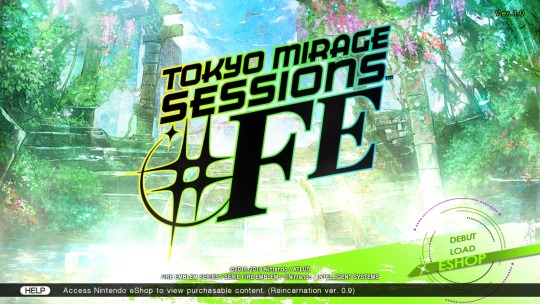
I’ll be talking about:
Story
Setting/Theme
Characters
Gameplay
1. Story
The story is nothing special - I enjoyed it, but it's a fairly typical jrpg "power of friendship and bonds" deal that is only made unique in any capacity by the idol culture that frames it. It's not bad, but it's not groundbreaking either. I wish the story were a bit longer to give more of a build up into the final confrontation. The earlier stages slowly start to set things up but even just one more dedicated chapter to ease into the final arc would have probably made the ending feel less rushed. That and I just enjoyed playing it overall and would liked more content.
The distinct chapters format to the flow may have been meant to simulate FE chapters while still also representing how persona stories often have noticeable breaks between dungeon arcs. In TMS though, it felt a bit more artificial, not damningly so, but I think the plot momentum was a bit worse for it.
The set up for each chapter break also revolves around Itsuki himself improving as an entertainer, even though he doesn’t know what direction he wants to focus on, and while it’s most emphasized early on, this aspect of Itsuki’s development himself feels almost abandoned or ignored through the mid and late game until the very end. The solution does make some sense, but some of the details that enable it to happen are a bit questionably contrived, and like the overall story, it felt a bit rushed in the final hour, based on what I remember.
Otherwise, the story did a good job of setting itself up, providing the characters with adequate motivation and means to seek the goals they set and each dungeon gave reasonable purpose for the main characters to tackle it.
The final chapter seemed to be trying to make up for the lack of build up by twisting and turning a bit more than usual, but most of its attempted twists were fairly standard fair for trying to draw out suspense and unfortunately were somewhat predictable for it. I was a little surprised at the host for the big bad, but mostly because I hadn’t been paying close enough attention so that was on me.
2. Setting/Theme

The Tokyo idol scene setting is the most interesting aspect of the story and while I can see it being polarizing, I found it novel myself. Mechanically, it does a good job of unifying the dungeons under a common theme of "things idols do" - such as posing for photo shoots or acting on TV.



Beyond dungeon design, the idol theme also naturally informed character designs and the multitude of costumes that appear throughout.
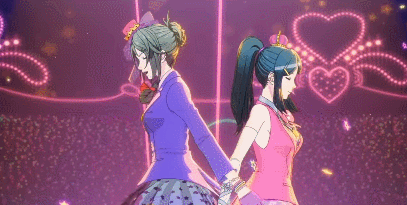
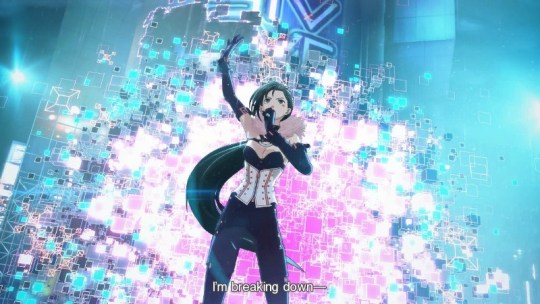

You can even see this thematic flair in the way that spell casting involves a character signing their autograph as a glyph!

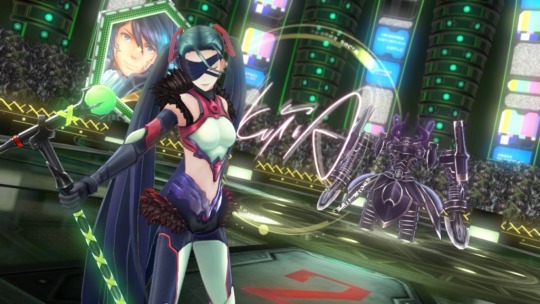
If there’s one oddity that stands out to me about the aesthetics of the game, it’s that the monster designs seem to be unable to decide whether they should be FE inspired or SMT inspired or neither, but even in the latter case most don’t seem to fit in with the idol theme in any capacity.
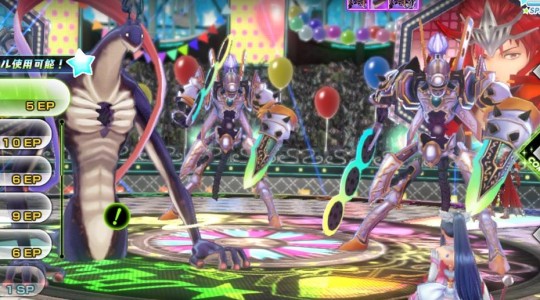
Even when enemies are FE inspired, they seem to have gone through a similar (if not more extreme) filter that the Mirage characters went through - becoming dramatically stylized and the only real purpose I can conceive for it is to make enemy classes that were definitely human in FE appear non-human here. For instance, the middle and right monsters above are myrmidon class enemies - unpromoted swordmasters from the FE universe.
Not to mention: Why do their out-of-combat sprites look like Organization XIII members!?

3. Characters

Like the story, the characters are good if nothing particularly revolutionary. Most seem built around one or two tropes but then are fleshed out beyond that which is fine. You learn more about them as you do their individual side quests (social links) and these do a good job of giving the feeling of evolving your bond with that character. The pacing of the side stories is mostly okay, though the gameplay reward for those that are plot locked to be very late doesn't always feel equal to how long you had to wait to do them. There's a bit of persona syndrome wherein all the chars get plenty of opportunities to interact with the MC, but would benefit from more time interacting with each other as well.
I liked all the characters in the end. There's a good variety between both the girls and boys, though because of join times some chars got more focused screen time than others. Again, I think a longer late game with more story side quests (instead of fetch quests) would have helped balance things out.
If I had to be as base as to rank the girls in terms of waifu ratings:
1. Eleonora
2. Tsubasa
3. Kiria
4. Maiko
5. Mamori = Tiki
Though it's worth noting that top four are all really close, and each slot only wins out over their competition by a small margin. I don’t dislike Mamori or Tiki, I just am not into the little sister appeal.

I suppose Barry Goodman is worth mentioning as well. Barry is a foreigner who settled in Japan and behaviorally embodies the most cringe-worthy aspects of otaku culture. He’s heavy-set, roughly groomed, and somewhat aggressive/abrasive about his passions. I’m not one to judge him for the subject of his passions, but the way he interacts with them would make me uncomfortable around him had he been a real person. Ultimately he is a good person at heart, but his poor people skills are unlikely to endear him to anyone on first impressions, and the fact that he doesn’t care only exacerbates his problems.
Finally, and predictably most disappointingly, the FE chars (heroes and villains) are barely developed and could be replaced with persona or persona like motifs without changing the overall plot. The FE aspect is little more than a coat of paint that gives secondary theme to the invading 'otherworld,' and it's a real shame and waste of potential.
Aside from the Mirage characters and Tiki themselves, there are however a few unmarked references that are at least self aware enough to be welcome Easter eggs for fire emblem fans:

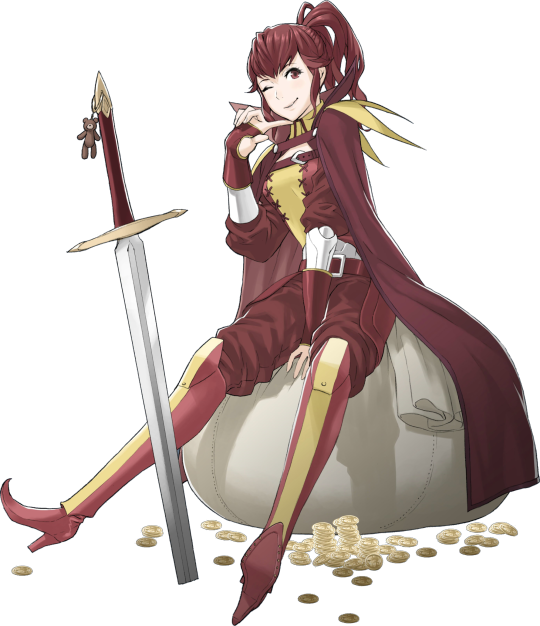
Anna is your convenience store shopkeeper, and there’s even a ‘shadow anna’ who will sell you more dubious dungeon consumables that a normal convenience store wouldn’t stock.


Ilyana works at the cafe, keeping close to her beloved food.
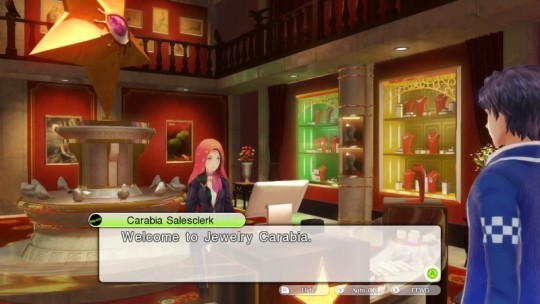
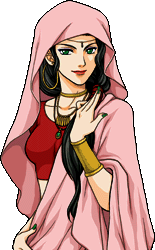
Aimee runs the jewelry store as she was the item store merchant in FE9 and 10
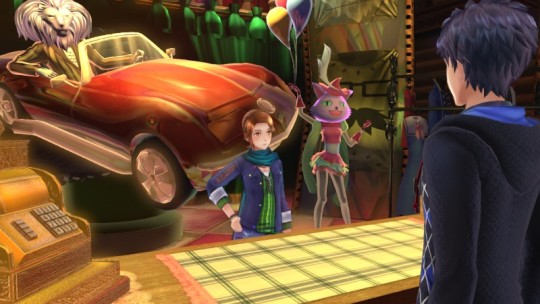

And Cath runs the costume shop. She’s a thief in FE6 with a distinct affinity for money, not unlike Anna, though not as extreme either. Admittedly, it’s been a while since I’ve read over her supports though.
I saw an npc employee at one of the random background shops in Shibuya central street that could also be Brady from FE Awakening, but the camera never got close enough to see him clearly enough to make a positive ID.
Finally, I found it amusing that all the playable chars' names are class puns/references
蒼井樹 = Aoi Itsuki > Aoi means blue in reference to FE lords typically having blue hair
織部つばさ = Oribe Tsubasa > Tsubasa in reference to her peg knight class
赤城斗馬 = Akagi Touma > 赤 (Aka) gives us “red” while 馬(uma) is “horse.” Red cavalier (partnered with a green cavalier) is a reoccurring archetype in FE. The Red cav tends to be the hot-headed one.
I can break down the others if desired, but these will do for examples.
4. Gameplay
Going to break this into a few parts:
General
Combat
Dungeons

1. General
The real reason this game is compared to Persona; gameplay mirrors a lot of persona's elements and it's almost easier to describe how it deviates from the Persona format than spend time detailing how they're the same. That said, if you like the persona formula (as I do), you'd probably enjoy TMS's gameplay flow as well.
While the lack of daily life and day limits for dungeons removes a lot of the tension of time management for them, I think it's fine since a lot of persona players rush dungeons in 1-2 days anyway and in TMS, once the dungeon is done, you don't have to worry about doing busy work to tick off the days until the plot is allowed to move forward again. The lack of social stats is an element of depth removed, but without a time cost element to activities, it makes sense and is probably a good thing for it to be absent from TMS (even if story wise it could have actually be viable as Aoi and the others grow their skills as performers).
Using the WiiU game pad as a smartphone screen to facilitate off-screen character interactions as well as display more detailed enemy information was clever if perhaps unnecessary (as persona 5 showed). Having the only map on the game pad actually made it a little disorienting to reference for me since my eyes had to leave my tv entirely, leading to me either holding my game pad up or bobbing my head up and down to compare my map with my surroundings. On the DS, the two screens are at least close by. I’d like to say there may have been a better use for the game pad, I’m not thinking of anything off the top of my head, so it may have been wise to minimize its use as a gimmick anyway.


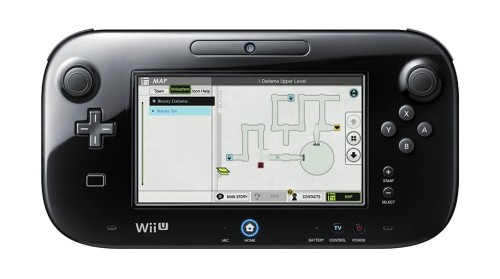
This is already in your phone history when you start the game, but it’s still probably my favorite moment from the text message logs:

#relatable.
Replacing persona fusion is a more straightforward crafting system that is the source for your weapons and passive skills, and in turn, much like Tales of Vesperia, your weapons are the source of your skills, both active and passive. The system sounds more grindy than it is in practice though. Simply advancing through the dungeons and fighting 70-80% of the monsters you encounter naturally will provide you with enough materials to forge most weapons as they become available. In fact there were a number of times when I ran out of new weapons to forge and had to push on with already mastered weapons equipped. I liked that bosses and some savage encounters would drop mats of a higher tier than what was readily available from current monsters, and you had to spend them wisely before advancing the plot to the point where those mats became common. It let you preview the next tier of weapons and abilities for select characters but who you gave those weapons to was never overly stressful since you could get the other weapons you passed on later anyway.
Rare monsters drop unique mats that can make weapons that give unusual or otherwise off-type skills to characters and it makes catching rare monsters that flee rather than engage the player rewarding. IIRC, I encountered fewer than ten rare monsters in my entire play through though, so I did not feel it worth the time to actively hunt them unless there was some trick to make them appear more reliably (and catching them was also a bit dependent on the surroundings). Like treasure monsters in P5, they usually had some kind of gimmick where they were only weak to one thing if they had any weakness and the latter ones also came with dodge [weakness] passive and had a chance of just up and running from battle.
2. Combat
The one-more mechanic is replaced by "Sessions" which are not unlike self contained one-more combos anyway. The tag in attacking animations were pretty fun and though late game sessions can get quite long, there’s no way to speed up or skip session animations, possibly in part because of the existence of duo arts which use the session animations as a timer. They could have prohibited skipping prior to deciding on a duo art and then allow skipping or speed up after, though. Long session animations didn’t bother me, personally though, as session attack animations were varied and interesting enough that I never got tired of even the early basic ones (most of which were replaced by late game).

Openly displayed turn order, plus some late game skills that can actually influence turn order were both welcome features as well.

Beyond sessions, specials, duo arts, and ad-lib performances were great at providing extra variety and changing the pace of what might otherwise be rote combat. While duo arts and ad-lib performances were rng bonuses that you mostly just take whatever you can get and be grateful, specials were more deliberate, needing a resource that builds slowly at first. Later on, with longer sessions and meter boosting passives, the sp gauge builds up much faster, but even then specials usually should be selected carefully, especially within boss battles where recovering lost sp is a bit trickier.
That said, special skills were not created equal. Even though buffs and debuffs are powerful, some of the later buffing and debuffing specials came late, at a point where I already had normal skills that could buff or debuff at almost if not the same potency without spending SP. Similarly, as my repertoire of skills grew, my ability to hit weaknesses improved and using specials to break through resistances became less necessary, even as monsters began appearing with more resistances.
Finally, Itsuki’s second special - “Strike A Pose,” was absurdly good and only got better as my session combos grew longer late game. The ability to give everyone twice the actions in a turn opens up so many other combos that often times, there was little reason to use offensive specials in favor of either two individual sessions or a concentrate/charge boosted session.
Inversely, I found myself using healing specials a lot less, and perhaps it was because I used Tsubasa a lot less late game - I made Chrom a great lord which gave Itsuki healing and support which was kinda Tsubasa’s niche previously, so with Touma able to out damage Tsubasa and Elly covering flying enemies, Tsubasa just wasn’t out in combat all that often, which meant Mamori was the only one with healing specials (which were helpful on occasion) but in the end using Strike A Pose allowed me to get normal heals out in extra abundance while still enabling attackers to make a play to help clear troublesome enemies.
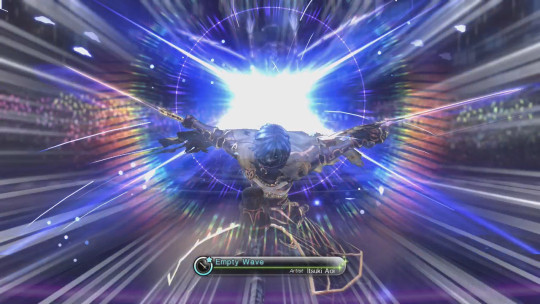
The FE weapon triangle’s representation in strengths and weaknesses among weapon types (not extending to magic though) gave a welcome way to predict weaknesses for enemies I had not encountered yet. One of the frustrating things about persona had always been that weakness/strength attributes for new monsters were difficult to predict and late game could cause you to walk into a bad situation that was never really your fault. Not only did the weapon triangle help mitigate some of the arbitrary mystery, but weaknesses were frequently consistent across similar enemy types at different levels even outside of the sword/lance/axe trinity. For example mage type enemies were, with few exceptions, all weak to swords and fire. Skills that deal effective damage (i.e. horseslayer/armorslayer) were also a great addition that gave characters tools to start session combos on enemies that they might otherwise be powerless against. The player also gets other ways to work around pesky resistances, features that are both welcome and necessary because...
If I have one glaring critic of the battle system it’s that Itsuki, like persona protags is mandatory. However, unlike persona protags, Itsuki has static combat tools and extremely limited ability to influence his own strength and weakness attributes. He’s always weak to fire and lances and since you can’t remove him from the front line, you always have someone in combat weak to those elements. Fortunately this is less deal breaking for the fact that Itsuki dying in combat doesn’t immediately game over (hallelujah!). In addition, later in the game most chars get passive skills that greatly increase their avoid against elements they’re weak to, Itsuki included. Still, being able to remove Itsuki from the front line would greatly increase your party diversity and flexibility. For a while after recruiting a second sword character, I had difficulty justifying putting him in the active party because Itsuki already filled the sword role. Eventually, I promoted Itsuki to a more support role and let the other char handle offensive sword plays.
One more minor complaint I have is the inability to swap out fallen allies. Having only three party members means that even one of them dying can be crippling, especially later on and on harder difficulties. I’ve wasted turns reviving downed allies and trying to heal back only for enemies to just repeat what killed someone in the first place and put me exactly where I was last turn with less healing items or sometimes in an even worse situation. While the boss dichotomy of easy/impossible with little in between that some persona bosses suffer from is present here, the existence of specials, ad-lib performances and duo performances that heal or revive greatly alleviate some of the comeback struggle that has a tendency to snowball in this combat system. As the only active non-rng option, specials in particular are important to the system. The severity of boss gimmicks isn’t quite as punishing in TMS compared to persona, but TMS’s smaller party size, can still cause a bad situation to cascade into unsalvageable territory.
3. Dungeons
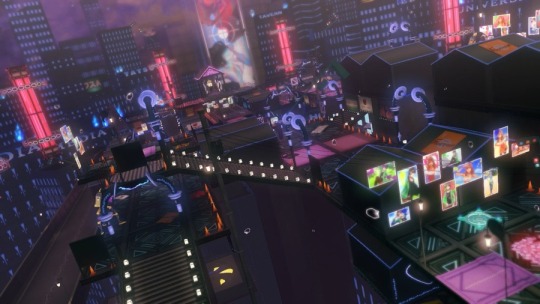
The dungeon design of TMS is interesting in that it departs from persona 3/4′s formula of randomly generated floors in favor of deliberately organized floor plans with usually only one correct path to the end. The linearity is sometimes broken up by treasures that you’ll have to backtrack for, but aside from that, there’s little mandatory backtracking within a dungeon. Dungeons stick around even after you clear them, allowing side stories to ask you to venture back over familiar ground for one task or another.
That said, the linear nature isn’t necessarily a bad thing. In TMS’s case, it allows the developers to give the player a learning curve for the dungeon’s mechanics and then challenge how well the player understood the earlier lessons, because the devs can guarantee that the player experienced the earlier sections before the later ones. It may sound obvious on paper, but it means that the developers can have a better awareness of the player’s competency at any given point in any dungeon, which is something that can’t be tracked when the player can go multiple routes at any given time. But I digress.
Another mechanical difference of note is how the player, Itsuki interacts with enemies pre-battle. In persona 3 and later, you could swing your weapon to hit an enemy in the field and that would start combat (at an advantage if they didn’t notice you), but in TMS, striking an opponent on the field knocks them back and stuns them, giving you the choice to then get closer and touch them to begin combat at an advantage or to avoid combat entirely. I like this greater degree of choice and it fits within the philosophy that TMS dungeons are made to be less stressful - less about meticulous resource management - than persona games. There’s still an incentive to engage in combat: you need to keep up a certain amount of level growth just to have the raw stats to beat bosses, but if you’re low on health and/or healing items or just plain short on available play time and you think or know there’s a checkpoint up ahead so you just want to make a push to reach it, you aren’t forced into battles you don’t want to engage in... with the exception of “Savage Encounters,” which are challenge monsters that seem to just exist to screw with you anyway. I think there was only one area prior to the last or second to last dungeons that had savage enemies I could actually beat albeit with great effort.
Playing TMS after Persona 5, it was also apparent that TMS’s idolaspheres were prototype palaces, from the set floor layouts and linear progression to the overarching themes of the dungeon informing its aesthetic and unique mechanics. In fact there are a number of things that TMS pinoeered for Atlus that then went on to feature in P5. You can read about some others here.
Puzzles were almost entirely navigation in nature - that is, how to use the dungeon mechanics and infrastructure to get from your start to your goal. It may be because it’s been a little over a month now, but none particularly stand out in my memory as being exceptionally good, while one or two I remember for being somewhat arduous or tiring. I’m still of the opinion that areas that the player is trying to solve puzzles in should have lower if not 0 encounter rate with random enemies, as battles, especially turn based ones that don’t tend to resolve in a single turn, can disrupt problem solving trains of thought.
Overall the dungeons are good though, and that’s important as they’re the meat of the gameplay. They are generally well paced with plenty to do and some minor stuff to find on your way to your target goal. Each dungeon’s unique mechanics fit with the dungeon theme and aside from a few exceptions the enemies are fairly distributed.
5. Conclusion
It has its flaws but I think, in the end, Tokyo Mirage Sessions #FE gets more right than it gets wrong. Even though the story was standard fair for this genre, I thoroughly enjoyed it and wished it had more content to its core for me to experience. I know there’s dlc, but the nature of dlc means that it’s nothing integral to the story and I’m not sure it would scratch the itch the way I want.
The setting is unique and the game fully embraces the themes it sets up and the themes in turn inform and affect almost every aspect of the game, giving it a unified appeal.
The combat is arguably more interesting than persona. It takes the same core formula of targeting weak points for massive damage but allows players more tools and freedom to circumvent bad matchups, make carefully planned strategic plays, or simply style on enemies with flashy satisfying attacks.
2 notes
·
View notes
Text
Success through Iteration
At Metatopia 2018, Mark Richardson and I ran a panel which you can listen to right now. Below are the notes I brought to that panel.
https://genesisoflegend.podbean.com/e/episode-190-success-through-iteration
Your game may change radically from inception to completion. Your goals will not, and they are the signpost to help you make every decision along the way. If your goal is to explore this novel mechanic or component, then you might change the game around it completely. If your goal is to practice your design skills, you'll likely try every variation and iteration you can imagine. The more specific your goal is—to create a LARP about pirates and families that leaves players feeling closer and warmer, for example—the more selective you can be pruning your choice tree. Know your goals.
You'll also use your goals to decide which playtest feedback to prioritize. You'll record it all, of course. But if someone tells you how to make your game more complex and that doesn't support any of your goals, don't act on that. Player suggestions, btw, are often traps; understand what deficiency they're trying to address and decide how (of even if) you want to address it.
While your primary goal shouldn't change, sub-goals might. If early tests show that your game could be really special in a way you hadn't imagined, you might make focusing on that a new sub-goal, if doing so doesn't compromise your primary goal. This is very common in exploratory and practice design. You might gain a new understanding of what makes good design or what makes a design yours, and start looking at your game through a new lens.
Between playtests, you will be tempted to change everything you can. If you're starting out, only ever change one thing at a time, changing another only after you understand the impact of the last change. After you've been at this for a few years, you can start testing changes together, but even then, only if they affect the game on separate axes (or if both changes are impossible without the other).
Have questions you're looking to answer. If you've built something, you're looking to see what it does in play, and how that advances your goals. If you've changed something, you have an hypothesis how it will affect play. Watch for your answers, and also ask your playtesters those questions to see if they evaluate them the same way.
There's a big difference between gameplay adjustment and balance tweaking. It's very literally the difference between design and development. Don't waste your time tweaking balance before the gameplay is final. Feedback works the same way in these phases: It's data to inform your understanding of the game and decisions around it—But balance feedback tends to be much more granular and is prone to be more petty (A player experiencing something they feel is unfair in the moment will always let you know, but will rarely have the perspective to know how fair it is or isn't).
Take notes. Note your own observations and every one shared with you. Later ruminate on the source of those factors, their significance, and other factors that could alter them. Don't forget why you made a change; if you do, you might not even remember that you made the change and end up testing the original again; even if you don't, you can't design blind—understanding is the key to design.
Fundamental to successful iteration is understanding your game, and distilling the difference between versions to their essence. If you can't do this, your iterations will test less and produce less new data. Many times, this requires logical analysis and math. Often, this will require some psychology. Intuition will help, and you'll build that up as you playtest more games critically—another good reason to trade playtests with your peers.
We see a lot of false positives and negatives in this field. This is exacerbated greatly by the high degree of variance in games relative to other media, as well as the diversity of players (true of all media). One great test doesn't mean your game is ready or flawless or even okay. One awful test doesn't mean it's bad, or unsalvageable. Sometimes you succeed in ways that are at odds with your goals.
A game is done when you test it three times in a row, everyone who could possibly love it does, you see nothing to tweak, and all your goals have been met as well as you can imagine. Or when the deadline hits. Give up on a game when you've tried all the possible routes and determined none will ever achieve your goals. Shelve a game when you're out of ideas how to iterate. It's fine. Half my published games were shelved multiples times for multiple years.
Sub-goals commonly over-looked:
Is your game as accessible as it can be?
Have you eliminated as many components and processes as possible?
Have you eliminated rules that aren't pulling their weight?
Are the rules as legible as possible?
How many blind tests have you run?
Is your game unique enough to stand out from the crowd? Mechanically? Thematically?
Is your game as long as it should be for its audience?
Is there too much variance? Is it too predictable? (It's the former.)
Does it represent only straight white men? Does it represent a culture you have no authority on?
Think of your career as a game designer as you would an individual game project. What's your goal? To be published? To be well-known? To make great games? To make a specific type of under-served game? To learn and grow? You can have multiple goals, but know what your ultimate goal is, and know the difference between a milestone and a goal. If your goal can be reached, will you be done with game design once you're there? If so, it's a milestone, not a goal.
Once you've identified your true goal, figure out what you might be doing that doesn't really serve it and stop doing that. Figure out what could serve it that you're not doing, and start. If your goal is to hone your craft as a designer, stop wasting time with graphic design or pitching to publishers; focus on exploration, iteration, and critical review from peers. If your goal is to make money in this industry, do the opposite.
Your first game is bad. Your first ten games are all pretty bad. Keep making games until you're good at making games. If you're still passionate about a design after a few years, apply the same principal and keep remaking that game until you're so good at making it, that you've made it great.
Iterate your processes too. Analyze how you do what you're doing, and how it can better serve your goals. Talk about your processes with your peers and try new methods out.
Iterate on Life. Try, show, evaluate, modify, talk, re-evaluate—everything.
1 note
·
View note
Text
Samsung Galaxy A31 Review
📷
Making sense of Samsung's Galaxy A and M series models is getting harder by the month, as new models are brought in with minor refreshes, but don't always line up in a logical order. For example, the very recent Galaxy M21 (Review) was basically a Galaxy M30s (Review) with a different selfie camera, but going by the model names, it's impossible to make that connection.
While some models in the A and M series have slight overlaps in pricing, there's still a relatively clear distinction between the series themselves. Generally speaking, most models in the A series tend to have better finishes and fancier features such as in-display fingerprint sensors, while the M series prioritises low prices.
Today, we'll be testing Samsung's new Galaxy A31, which, on paper, should succeed the Galaxy A30s. Compared to the latter, the new model offers a fourth rear camera, a bigger battery, a higher-resolution display, full support for Samsung Pay, and of course a higher price tag. Available in just a single configuration with 6GB of RAM and 128GB of storage for Rs. 21,999, does the Galaxy A31 deserve a spot in our coveted list of top phones under Rs. 25,000?. Let's have a look
Samsung Galaxy A31 Design: Been there, seen that
Even though the design of the Galaxy A31 isn't exactly fresh for a budget Samsung device, I do like the fact that it's slim and light. The all-polycarbonate body feels quite sturdy but it does pick up fingerprints easily. The phone has a noticeably thick chin below the screen, and an Infinity-U cutout at the top for the selfie camera.
There's a huge SIM tray on the left, for two SIM cards and a microSD card. The headphone jack, USB Type-C port, and a speaker are at the bottom. The back features Samsung's Prism Crush pattern, of which we have the blue variant. This phone is also available in back and white trims. The quad-camera cluster at the back is a rectangular module and doesn't bulge outward much.
Overall, the Galaxy A31 was comfortable to use on a daily basis during this review. It's a little wide, and reaching the top of the display isn't the easiest, but One UI has gestures to help with this. After seeing many phones in the series with the same pattern on the back, the design has started to feel a little boring at this point. The box contents are pretty standard too: there's a silicone case, a charger, a USB cable, and a headset.
📷
Samsung Galaxy A31 Display: AMOLED never disappoints
The Galaxy A31 has a sharp 6.4-inch full-HD+ (1080x2400 pixels) Super AMOLED display. I found it to be more than adequate in terms of brightness, even in the daytime. Colours were a bit too rich for my taste in the default ‘Vivid' mode, but this can be toned down in the settings. The display is flat, without any curves on the sides, but there are no sharp edges either so performing gestures isn't a problem.
There's an in-display fingerprint sensor, which isn't very quick but works well as long as you give it a firm press. The time taken to wake the screen, along with the fingerprint animations, make this whole process feel a bit laggy. I usually relied on face recognition, which I found to be quicker. The always-on display has basic customisations such as the ability to show what song is playing, and a choice of different clock styles.
Samsung Galaxy A31 Performance: Quite disappointing
Despite its decent build quality and good display, its performance is a big issue. Samsung has used the MediaTek Helio P65 octa-core SoC, and I would have no problem with it on a phone that costs Rs. 10,000, but I certainly don't expect it on something that costs above Rs. 20,000. Compared to even the Galaxy M21, which uses the Exynos 9611 and costs a lot less, the Galaxy A31 is slower in most of the popular benchmarks.
Samsung's One UI v2.1, based on Android 10, also feels a bit sluggish overall. There's a persistent hint of stutter in the animations, and lag when I was switching between apps. It didn't hamper usage too much but having to wait that extra second or two for things to happen is not an experience I expect at this price point. One UI itself is fairly feature-rich with lots of shortcuts, themes, and gestures to play around with. There's also Dolby Atmos, but only for wired and wireless headphones.
The Galaxy A31 supports Google's Widevine L1 certification, which means video streaming apps can play content at the display's native resolution. The single speaker gets fairly loud but the audio quality is strictly average. Simple games run well, but heavier titles such as Asphalt 9: Legends or even PUBG Mobile ran at reduced graphics settings. Gameplay was tolerable but they didn't look as good as they should have. I also noticed a bit of heating when playing games for longer durations.
📷
Samsung Galaxy A31 Cameras: The disappointment continues
Okay, so far the Galaxy A31 isn't looking too appealing, but perhaps it can redeem itself with its camera performance. The four cameras on the back include a primary 48-megapixel sensor, an 8-megapixel sensor with a wide-angle lens, a 5-megapixel depth camera, and a 5-megapixel macro camera. The apertures of all the cameras aren't particularly impressive, with even the one on the main camera being just f/2.0. The front camera uses a 20-megapixel sensor.
The camera app should be familiar to most Samsung users, though I did find a few missing features which ought to have been there. Keeping in mind the price of the phone and its positioning in the series, it's a little odd to not have 4K video recording as an option, and even a Night mode for low-light stills. Pro mode is crippled, with no option to adjust the shutter speed. Autofocus speed is decent, but this phone tends to hunt for focus in low light.
You do get Samsung's ‘Scene optimiser' AI engine, and the ability to save stills and video in the HEIF and HEVC formats. Under good light, the main sensor captures decent-looking photos. Images are captured as 12-megapixel shots by default but you can shoot at the full 48-megapixel resolution if needed. In low light, noise is suppressed well but details are lacking, which is noticeable when you zoom in to photos a bit. Close-ups shot under good light fare better, with good details and colours, but due to shutter lag, even slight movements can cause blurring.
The wide-angle camera captures comparatively weaker details, and HDR isn't as effective as on the main camera. In low light, details are much worse and there's no Night mode to help salvage shots.
Live Focus works decently well, and the amount of background blur can be adjusted for portrait shots. The macro camera does a fair job with extreme close-ups but I didn't find image quality to be much better than what I've seen from phones with 2-megapixel sensors.
Videos are limited to 1080p resolution, but quality is decent given ample light when shooting with the primary camera. The Galaxy A31 doesn't offer even electronic stabilisation, so movements with the camera look jerky. You can't switch to the wide-angle camera while recording but you can switch to it before you begin. As expected, video quality is just about acceptable under good light but very poor in low light. There's no stabilisation here either.
The selfie camera captures 12-megapixel stills by default (8 megapixels if you choose a tighter crop). However, you can shoot at the native resolution too. Selfies are generally usable when shooting outdoors, in daylight. Skin tones tend to look a little too warm and HDR can be a hit or miss, but it's not too bad. The camera struggles to reproduce good details in low light, often leaving you with soft textures and weak details.
Overall, the cameras on the Galaxy A31 are very underwhelming and lack many features that you'd find in many phones that cost a lot less.
Samsung Galaxy A31 Battery: Pretty good
If there is one redeeming quality about the Galaxy A31, then it would be battery life. The 5,000mAh battery lasted for 18 hours and 11 minutes in our HD video loop test, which is very good. Even with regular usage, I was easily able to go well beyond a day on a single charge. There is 15W fast charging, so you can charge the battery up to 50 percent in an hour, but filling it completely takes well over two hours
Verdict: Who is the Samsung Galaxy A31 for?
I'm struggling to find a good reason for the Galaxy A31 to exist, and I honestly cannot think of one. It seems as though Samsung has launched it simply to fill the price gap between the Galaxy A50s₹ 22,990 (Review) and the Galaxy A51₹ 23,990 (Review) — either of which would be a much better pick than the Galaxy A31. Battery life is the main standout feature here, along with the decent build quality and display.
However, the middling SoC performance and underwhelming cameras are faults that are too glaring to ignore when you're paying more than Rs. 20,000. Even if the price were to drop, there are plenty of more powerful and feature-rich options in the market such as Samsung's own Galaxy A50s and Galaxy M31, or phones from Realme and Xiaomi.
0 notes
Text
Final Fantasy II review
One of the most interesting parts of the Final Fantasy series, and a big reason why I’m so fond of it, is that every main series game takes its own approach to the gameplay. From the job systems of III and V, the Materia system of VII, the Junctioning system of VIII, or the straight up action combat of XV, every game has a different focus that makes them stand out, and while the results can certainly fall short at times, it’s still something worth commending. For example, take the subject of today’s review, Final Fantasy II. For the second game in the series, and a game that came out in 1988, it’s a huge step up from the original game in a lot of ways. A much more detailed plot, containing several defined playable and supporting characters, a much more experimental battle system, the introduction of many elements, gameplay and otherwise, that would establish a true identity for the series, away from just being a ripoff of Dungeons & Dragons 1st edition, it’s an impressive and critical step forward for the series. Unfortunately for the game, it hasn’t been 1988 in over 30 years, and it’s now easily the weakest game in the series in my opinion. As for why that is, well, that’s what we’re taking a look at today. As with the first game, I’m reviewing the PSP version. Note I’ll be pretty lax with spoilers, so take caution, if you actually care to avoid spoilers.

Story:
Final Fantasy II takes place in an entirely different world than Final Fantasy I, a tradition that every main series game would follow. The peace of this world is shattered after the rise of Emperor Mateus of Palamecia, who, bent on world domination, raises a fearsome army and unleashes the denizens of Hell upon the land, conquering a large portion of the world. The city of Fynn organizes a large resistance effort, only to be attacked by the Emperor’s army, forcing a small remnant to flee to the town of Altair, establishing the Wild Rose Rebellion, led by Princess Hilda. During the fall of Fynn, four youths, Firion, Maria, Guy, and Leon, attempted to escape as well, only to be attacked and left for dead by the Emperor’s soldiers, with Leon going missing as well. Rescued by the rebellion, and healed by the white wizard Minwu, Firion, Maria, and Guy, having nothing left to return to, and wishing to search for the missing Leon, join the rebellion to fight back against Palamecia. Meanwhile, the Emperor, his army having taken heavy losses taking Fynn, takes to devising much less conventional methods of establishing his rule, starting with a massive airship called the Dreadnought, meant to scare the populace into obedience, on threat of total destruction.
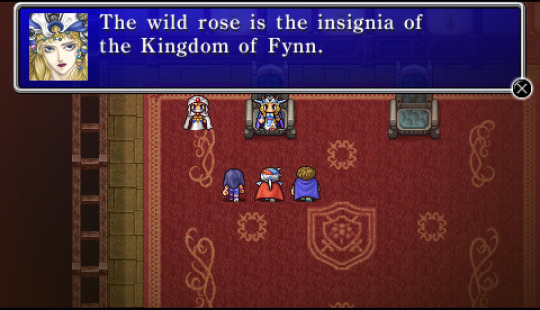
Compared to the very light plot of Final Fantasy I, the story here is much more involved. Instead of wandering between locations more or less aimlessly, there’s always an explicit plot reason to go to new locations, the party being given tasks like finding mythril to supply the rebellion with better equipment, or trying to recruit potential allies. Compared to the party in the first game just being completely blank slates, the party consists of the more distinctive Firion, Maria, and Guy, with the fourth slot being filled by various guest characters that come and go as the story goes on, such as Gordon, the prince of the fallen kingdom of Kashuan, and Ricard Highwind, the last of the dragoons, and there’s actually an established side cast, including characters like Hilda, the leader of the rebellion and princess of Fynn, Paul, a noble thief assisting the rebellion, and Cid, a former knight who maintains the world’s only airship, with this notably being Cid’s first appearance in the series.
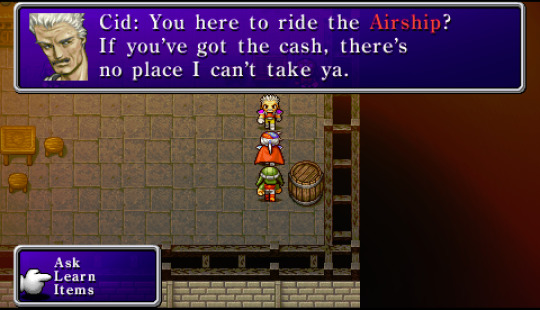
Final Fantasy II is also very noticeably darker than the first game. While the plot circumstances of the first game weren’t exactly cheerful, with the world falling apart due to the influence of the Fiends, outside of a select few towns, this wasn’t very obvious, and the game overall carried a bright, adventurous feel. Not so with Final Fantasy II, where the Emperor is a much more prominent and ruthless villain who’s already conquered or ruined a majority of the world, always keeping another plan on standby, and staying one step ahead of the heroes. Many characters die over the story, from random NPCs to even temporary party members, and the game overall carries a prominent melancholic, empty feel to it, one that’s very impressive considering the time it was made.
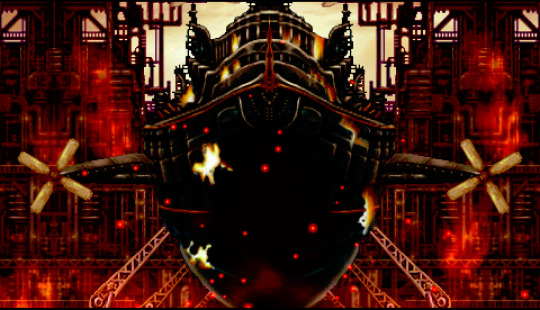
To be honest, however, it actually goes a bit too far in this regard. Almost everything the protagonists accomplish comes at the cost of allies dying, or something preventing them from fully completing their mission. Many NPCs are pessimistic about the chances of humanity being able to win against the Emperor, and so much destruction is wrought upon the world by the end that it seems there’s not even much left to save. From the very beginning of the game, which starts with your party instantly being destroyed in an unwinnable battle, the game is nothing but a constant stream of death and hollow victories, with plenty of characters you can find mourning their losses, and there’s very, very few points in the story that offer any sort of relief from it. Combined with the Emperor barely seeming bothered by anything the party accomplishes, and running circles around them more than a few times, it’s very easy to simply lose any investment in the story.
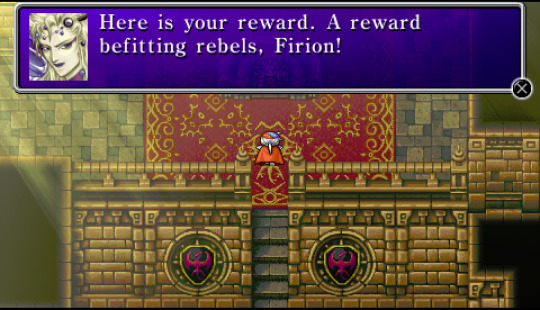
The characters unfortunately only add to this lack of investment. It’s hard to hold it against the game, but the main party of Firion, Maria, and Guy is still easily the least developed cast in the series. They have little dialogue to themselves to begin with, and have very minimal personality traits, especially Firion, who pretty much only exists to be the hero by default. Additionally, whereas in most RPGs, the cast’s varying personalities and skills tend to gain importance, here, the only skill any of them have is Guy being able to talk to beavers, which only comes up once in a way that doesn’t even affect the story, and, again, they have nearly no personality otherwise, which totals out to each of them having, at best, 1 moment each throughout the story where they’re not completely interchangeable with each other, which barely elevates them above the completely blank slate party of FF1.
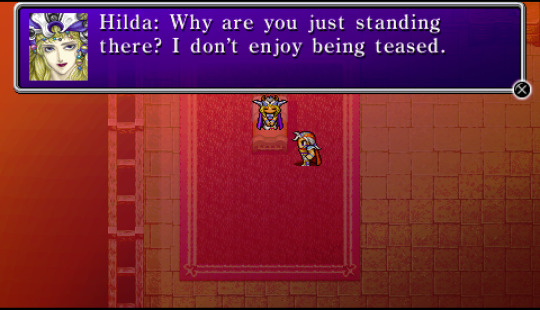
The guest party members and NPCs fair a bit better, but not by much. The guests tend to be at least mildly interesting, like the fatalistic Minwu, the cowardly Gordon, who learns to be courageous as the story goes on, to the pirate girl Leila, but they’re still nothing special, and there’s surprisingly few other NPCs, most of which aren’t too memorable either. Even the Emperor himself is about one of the most stereotypical evil emperor characters you could have, not helped by the very few scenes he gets. That’s not to say he’s a bad villain, though. His successfulness does create a presence that looms over the entire story, and he pulls off one of the coolest plot twists in the series; after being killed by the party in a very easy battle late in the game, he simply returns as a demon himself, having become far, far stronger than he had ever been in life, to the point of taking over Hell itself. It’s such a unique and unexpected twist on the seemingly weak political villain that it alone cements the Emperor as one of the more memorable villains in the series. Overall, while the writing of the game is quite impressive for the time, and laid a good deal of groundwork for the improved writing of future entries, it’s just passable at best nowadays.
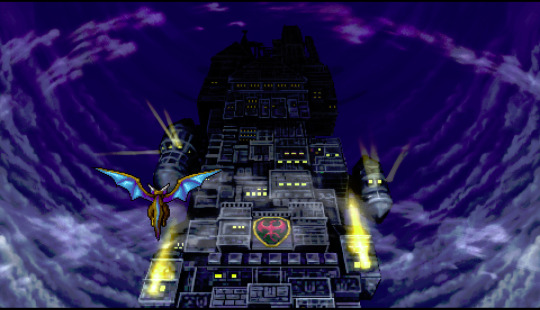
Gameplay:
Here’s where things really start falling apart. On the surface, not much the combat doesn’t seem terribly different from Final Fantasy I, with it still being a standard turn based system with basic commands like attacking, using magic, and defending. The big differences in Final Fantasy II’s combat lie in the character progression. The first game had you simply selecting a party of 4 classes at the start of the game, gradually making them stronger across the game by leveling them up and acquiring specific equipment and spells for each, like pretty much every normal JRPG. FF2, on the other hand, uses a much more complex system. Every party member is capable of using every weapon and learning every spell, in the process abandoning the D&D system of set spell charges and instead introducing the traditional MP system, and characters are not set in specialized classes and roles. Instead, FF2 discards the usual EXP based leveling system, and instead uses a stat leveling system, where the individual stats of each character level up separately depending on the course of battle, and while each character starts with predetermined stats that favor a particular role for them, with enough grinding, you can still reshape them however you wish. This stat growth system would later be used and refined for the SaGa series, and it’s a very ambitious attempt at improving upon the party building system the first game established.

In total, there are 12 main stats that can be increased through battle: HP, your health points, which is raised in regular intervals, or losing HP in battle, MP, magic points that allow you to use spells, which is raised by having MP reduced in battle, Strength, which determines your physical attack, and is raised by using the attack command, Magic, which determines how much MP you get when it is gained, and is raised by having MP reduced in battle, Spirit, which determines the strength of white magic spells, and is raised by casting white magic in battle, Intelligence, which determines the strength of black magic spells, and is raised casting black magic in battle, Stamina, which determines how much HP you get when it is gained, and is increased by losing HP in battle, Evasion, which determines how likely a character can dodge physical attacks, and is raised by being targeted by attacks in battle, Agility, which factors into evasion calculation, and is raised by having high evasion, and Magic Defense, which determines how resilient a character is to offensive magic, and is raised by being targeted by offensive magic in battle.
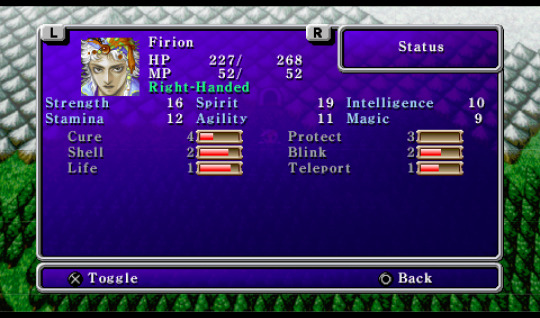
However, it doesn’t stop there, as individual weapon types and spells also have levels that can be raised, which is done so by gaining skill points in them by attacking or casting them during battle. Once enough skill points are gained, they advance to the next level, with the hard cap being 16. Gaining weapon levels allows that character to be more accurate and attack more times at once with that type of weapon, and raising spell levels increases their power and makes them more accurate. Each weapon type, consisting of swords, spears, axes, staves, knives, bows, shields, and unarmed, have different attributes, such as spears being a relatively balanced type, with lower individual power than swords and axes, but higher accuracy, while bows are allow characters to attack from the newly introduced back row, which makes them immune to physical attacks, but prevents them from attacking with any other weapon type. While focusing on one weapon type with each character would seem the most efficient, the game only tends to give you one or two weapons of each type at a time, many of which have good boosts in power or added effects, making focusing on a few different types a decent idea.

Shields are unique in that, while equipping them doesn’t raise your defense as might be expected, and actually lower your attack, they give large evasion bonuses that makes dodging attacks much easier, and have the chance of blocking a physical attack completely even if something does connect, all of which increases as you gain levels in it. As for other defensive equipment, you have heavy and light types of armor, with light armor giving less defense bonuses than their heavier counterparts, but not weighing nearly as much, and thus leaving you much more evade. As for spells, they start out very underpowered, and have awful accuracy in the case of buff and debuff spells, but become much more effective after a few levels, with the downside of them costing more MP to cast with each level gained. Characters can learn up to 16 spells, and are free to remove them at any time, at the cost of having to level them again from scratch if they ever relearn them. Instead of simply learn spells by buying them in towns, spells are instead learned from tomes, which can be bought from shops, found in treasure chests, or dropped from enemies. Using them on the field teaches a character that spell, while using the tomes in battle instead casts a high level version of the spell, at the cost of losing that tome.
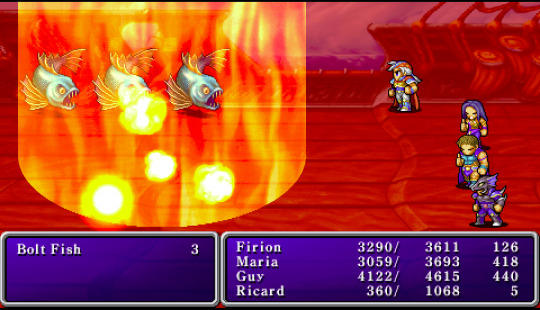
Unfortunately, as creative as this all is, this system has some serious issues. The main one, which you have already guessed, is that the game is incredibly, incredibly grindy because of these mechanics, and in a much worse way than most other RPGs. While not every stat is going to be important for each character, depending on how you build them, there’s still a lot of things it forces you to keep track of. Even if you want to make a dedicated mage, sticking in the back row with a bow for the whole game will leave them with so little vitality and HP that they’ll just be uncomfortably fragile, and with the magic attacks enemies have by the endgame, you really want to keep them in the front row for a good part of the game. Most spells, including important ones like Life and Esuna, for reviving party members and removing status effects respectively, while extremely useful, have such horrible accuracy to start that they’re completely useless before you level them up, and the weapon distribution is quite unbalanced, with swords having easily the best selection even in the midgame, essentially leaving most other types as stopgaps.

While you might level your important stats a good bit just naturally going through areas, trying to deliberately level any of them is a commitment. While HP, strength, spirit, intelligence, and magic defense tend to come easily enough, increasing stamina often only happens through the loss of a large chunk of their maximum HP, which, obviously, preferably doesn’t happen on a regular basis. This goes likewise for MP and magic, which is rather irritating, as not only do you need more and more MP as your spells level up, but ways to restore MP are extremely limited and costly. The bizarre loop of agility factoring in to evasion increasing, while itself only leveling up based on your current evasion, means that the only reliable way of increasing either is to equip the lightest equipment you have. While leveling up weapon levels is easy enough, especially since you can dual wield different types at once, leveling up spells is a much slower process, with casting low level spells during random encounters, even those that won’t actually help at the moment, often being one of the only feasible ways to get them leveled quick. You may even be tempted to ignore magic beyond simple spells like Cure because of the individual effort needed, but the game will quickly hammer the importance of magic into you; from the randomly encountered flans and bombs that either have absurd physical defense or tend to explode if not fully defeated in one turn, with magic being the only reasonable way to take them out, to mandatory bosses that hit quite hard, and also have enough physical defense to make physical attacks nearly worthless without absurd grinding, you’re not getting through the early game without dedicating some time to magic. On the flip side, another early dungeon has a boss that outright absorbs magic, making physical attacks the only way to beat it.

The game has quite a reputation for being brutal, and it’s not inaccurate, with most dungeons being more than glad to beat you down without remorse, and there’s tons of troublesome enemies to be found throughout the game, doubly so if you try to go for all the treasure chests in the area, as many of them are guarded by encounters called monster-in-a-box, which are often much more powerful than other encounters around. Most bosses are more than happy to make your life miserable too, especially the infamous Lamia Queen and Behemoth. However, this difficulty is in no way fair or well designed. While the growth system can easily leave you unsure as to whether or not you’re prepared for a dungeon, since you have no easy guideline to go off of compared to standard leveling, that’s not even the worst of it. The design of the dungeons, and even the world map, are horrible. There’s tons of doors scattered throughout pretty much every dungeon, and 90% of them lead to dead end rooms with raised encounter rates. There is absolutely no way to tell which doors are dead ends and which are necessary to progress, so you’re reduced to trial and error, which is extremely exhausting when there’s so many doors per dungeon, and you’re almost guaranteed to get into an encounter before you can leave each one, and if you’re tempted to ignore any doors when they don’t seem mandatory to progress, in many of those cases, there’s treasure rooms hidden among them, once again with no way to figure out other than guessing.
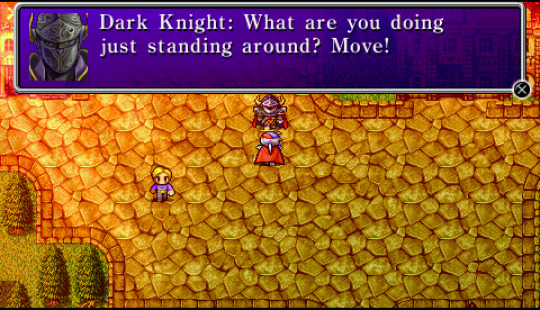
The world map, on the other hand, is one of the best arguments against open ended world design there is. Compared to the first game, there are almost no physical obstacles barring where you can go, other than a few rivers that are only crossable by canoe, something you get almost immediately, and a few areas only accessible by boat. Instead, you’re kept out of where you’re not supposed to be through the Dragon Quest 1 method of having the random encounters kill you horribly. The problems with this method are twofold: not only are the borders between where you’re supposed to be and where you’re not very thin, to the point of running into late game enemies just outside of the first town if you go just a biiit too far to the left, compared to Dragon Quest 1 often using bridges as visible borders between areas, but it just doesn’t really fit with how the game is designed. Dragon Quest 1′s pacing is rather relaxed, as while you do have plot objectives, the game doesn’t rush you to fulfill them. You’re meant to just hang around the areas you can survive in, grinding your way up and getting whatever equipment you need until you feel confident to move onto whichever area seems to be designed for next. In Final Fantasy II, you’re constantly being sent back and forth between areas to get new orders or do whatever the plot wants of you at that moment, but while the game loves telling where to go, it’s pretty bad at telling you how to get there, with its often vague directions being spread out between NPCs in multiple towns, to boot. While there is a map of the overworld you can access, it can still get pretty annoying having to meticulously check where you’re going, and you’re still liable to being decimated just because you wandered into a harmless seeming area. One nasty example comes after completing Kashuon Keep, not too far into the game. You’re expected to head back to Altair, which is on the other side of the world and is quite a bit of a walk, but heading south soon loops back to the Altair area, making for a much shorter walk. Trying to put this idea into practice, however, sends you across the large Palamecian desert, full of enemies more than eager to tell you that this area is still a few dungeons away from being accessed. It’s not completely unsurvivable, and can be safely traversed by finding the nearby hidden Chocobo, but it’s still a nasty situation after a very irritating dungeon.
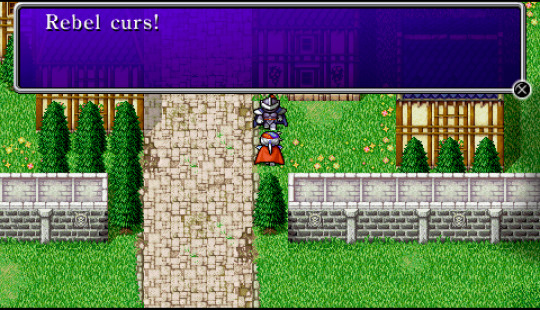
The biggest, and most frustrating, source of difficulty, however, is that the game stubbornly refuses to tell you anything about what’s going on behind the scenes. There’s so many mechanics left unexplained that cause a lot of difficulty if you don’t understand them. For example, every enemy has a stat called rank, which determines how many skill points for your weapons and magic you’ll actually get by using them on said foes. Essentially, if your weapon or magic levels are higher than the enemy’s rank, you need to use that weapon or spell more times in that battle based on the difference between the numbers to actually get any skill points. Not an unreasonable system, and you can view every enemy’s rank in the bestiary, but the game never directly addresses this, and even the most powerful enemies only go up to rank 10, effectively softcapping your skills and spells at 10, which often leads into having your party attack each other to bypass the entire mechanic, a depressingly efficient solution most of the time. Other stats the game never cares to explain are evasion and magic defense, which both display both numbers and percentages. For evasion, the number represents the number of attacks that character is capable of dodging, as physical attacks strike multiple times per round, and the likeliness of evading each attack. With magic defense, the number represents the number of attempts at avoiding a status effect can be made, and the percentage represents the chance of successfully doing so. Despite the name, the stat does not reduce damage taken from magic attacks.

On the subject of magic, the spells available to you are also plagued with unneeded complexity and vagueness. First off, the descriptions for many spells tend to only give you the barest idea of what they actually do; Aura “Enhances effectiveness against various foes.” It never tells you what enemy types count, or that it only becomes effective against certain types as its level increases, you just have to hope that it’s working whenever you use it. Barrier “Raises a barrier to defend against special attacks.”, again giving you no indication as to what it’s actually protecting against. Shell and Wall both claim to raise magic defense, but give no obvious indication how they’re actually different from each other, and Dispel claims to remove protective magical barriers, which lowers the target’s magic defense, even though you may infer that it removes buffs, like in later games. Other spells tend to be redundant or very situational. Basuna removes temporary status effects, compared to Esuna removing permanent status effects, which is near worthless since not only do temporary effects wear off after a number of turns, but they go away after battle regardless, and are rarely effective enough to waste a turn removing. Fear increases the likelyhood of enemies fleeing battle, which is not only rare to actually work, but is worthless, since you don’t get any credit for defeating any enemies that do flee. Sap reduces the MP of the target, which is not only rarely likely to work, but counterintuitive if you have the infamous Osmose spell, which saps large amounts of MP while restoring the same amount for the user. Status effects also have different elements to them, namely body, mind, and matter, with most enemies having different resistances. Some spells, like Stop and Paralysis, have the same effect, but different elements, and keeping track is both difficult, both remembering which spell is which element, and what enemies are actually affected by each element, and nearly pointless, since the effects are rarely worth bothering with in favor of just attacking. Matter elemental spells, however, are rarely resisted by most enemies, even bosses, and mostly comprise of instant death spells like Mini, Break, Teleport, and most infamously, Toad. Not only does this game make instant death spells effective, it makes them downright overpowered, with almost every encounter being capable of being solved through judicious application of Toad.

But the peak of all this is a special property that some enemies, like ghosts and the final boss, have applied to their physical attacks: a draining effect that not only restores their HP by the amount of damage inflicted, but specifically inflicts 1/16th of the target’s maximum HP per hit, with them eventually attacking 8 times per turn by the final dungeon. To sum this up simply, this makes heavier equipment worse than worthless. Not only will the defensive power do nothing to protect from this damage, but it actively weighs you down and destroys your evasion, guaranteeing you’ll take all those possible hits unless your did some extreme evasion grinding. You’d be protected better by not wearing anything at all, because at least then you’ll make use of all your natural evasion. Unless you want to constantly heal your characters for half their health everytime you run into specific encounters, you have to dedicate a lot of your time, or most of your run through the game, to getting their evasion leveled enough that this isn’t a problem. Knowing this can be the difference between fruitlessly blowing all your resources and breezing through effortlessly, and there is a certain weapon, the Blood Sword, that has this same draining effect, which can singlehandedly annihilate the final boss once you’ve figured this out. While there’s a few other smaller issues, like several encounter formations that cannot be ran from for no apparent reason, other than possibly being formations used in certain monster-in-a-box encounters, those are the main issues, and being aware of them, and having the information to circumvent them, makes the game much, much easier. If anything, it makes the game extremely breakable. From physical attackers that dodge everything thrown at them, to spellcasters that can wipe out encounters with a single cast, it doesn’t take much to erase the difficulty once you know what you’re doing.

As for bonus content, there’s Soul of Rebirth, a bonus mode unlocked after completing the main game, first added in the GBA version, which focuses on several characters who die in the course of the story finding themselves in what they think is the Jade Passage, the path to Hell. While a cool concept that has a really neat final boss of its own, namely the light side of the Emperor, who split off from his dark half after death and instead took over Heaven, it still has issues of its own, namely that most of the party are guest characters in the main game, and carry over the stats, equipment, and spells they had when they left the party, meaning if you didn’t bother training them and stripped them of all equipment before they departed, you’re in an absurd time. The mode is also quite short, and only consists of two dungeons that are just mirrored versions of the final two dungeons of the main game and a town. A neat addition, but not much more than that. Other than that, the only optional content to find in the main game is the Arcane Labyrinth, a bonus dungeon added specifically for the PSP release. The game uses a keyword system where you can learn important terms from NPCs, and ask about those terms to get directions or a bit more plot. It’s sort of neat in concept, but in practice it doesn’t amount to much other than make it slightly more annoying to find out what to do, especially if you manage to miss a keyword. The Arcane Labyrinth, however, revolves around its use. In order to progress past the entrance, you must select a keyword at the portal to the next floor, which then takes you to a specific floor based around the keyword you chose. Almost every floor has a little sidequest to solve, like defeating specific enemies or giving items to NPCs, which give you new keywords exclusive to the labyrinth, or hints for some of the trickier floors. While they can be kinda annoying to do, you only ever have to complete them once for their reward, and can otherwise run straight to the exit on subsequent visits.
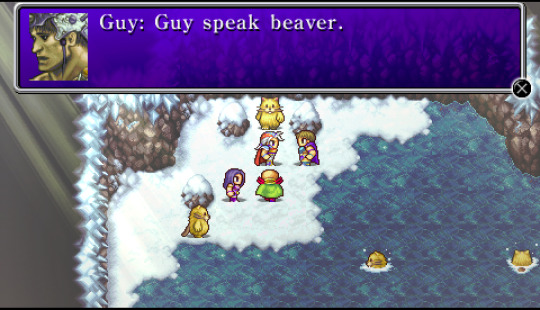
Every floor requires you to select keywords for the next, with 45 different floors being available in total, and the Arcane Labyrinth is actually split into 3 sections, with the northwest section requiring four floors to be visited, the northeast seven floors, and the south ten floors, though while you can’t visit the same floor twice in the same section, you can choose repeats in separate sections. There is much more strategy than simply randomly selecting floors, however. Each keyword belongs to a different category, which cause different reactions depending on your next choice. Picking keywords in the same category in a row cause better treasure to spawn and lower the encounter rate, while picking something in a category that opposes it, such as a matter and materials floor after going through a magic and spirits floor, has the opposite effect. Even more importantly, each playable character has a set of keywords that resonate with them, to varying degrees. This becomes important after finishing all three sections, which unlocks the Arcane Sanctuary. Within is Deumion, the master of the Labyrinth, who summons a superboss, Phrekyos, to test you, with its strength varying depending on how many keywords you’ve gotten through the story, making it beatable even in earlier parts of the game. Beating Phrekyos allows you to get a reward from Deumion; if you picked enough keywords that resonate with a certain party member, you will be able to get their ultimate weapon, which not only have tons of power, but confer massive stat boosts when equipped. If your keywords didn’t resonate enough, you only get an elixir, something that you can buy, albeit with absurd amounts of money. The optimal keywords for the main party are only unlocked in the endgame, but it can actually be worth visiting early for the party members that are used in Soul of Rebirth, as the weapons make it much more manageable, though visiting too early can end with you being much too powerful compared to how you should be. A special set of keywords also allow you to see Deumion’s past, leaving you able to either peacefully receive from him the Revive spell, or fight him as the ultimate superboss for the Destroy spell. Both are disgustingly impractical, but it’s a neat idea nonetheless. Overall, the Arcane Labyrinth, though still rife with its own set of frustrations, is actually one of the more enjoyable bonus dungeons I’ve come across, with a very creative concept that actually leaves you curious as to what the next floor could hold.
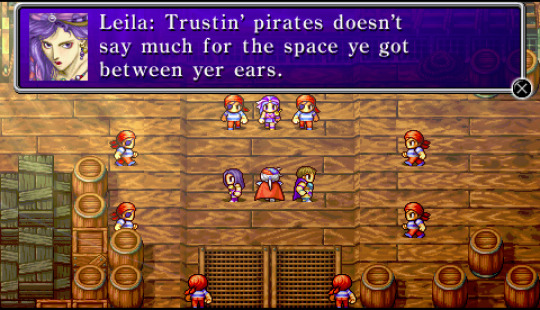
Overall, while the gameplay of Final Fantasy II has some interesting ideas, it’s held back by an irritating lack of explanation as to how it works, the overly grindy design, and just plain poor design and execution. It’s a miserable experience that makes even other early JRPGs seem appealing, just because their grinding is so much simpler to handle, and I need to note, this is the most polished version of the game. Between bugs, a horribly limited inventory, and even more absurd design decisions, like stats sometimes decreasing instead of increasing, or weapons massively decreasing magic accuracy, and increasing skills taking even longer, any version earlier than the GBA version is even more infuriating and even less playable.
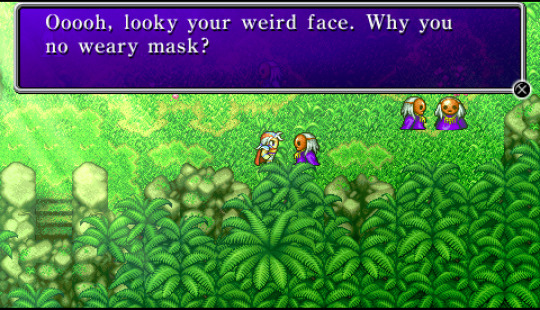
Graphics:
Final Fantasy II is actually a quite nice looking game, as with the rest of the Final Fantasy releases on PSP. Locations have a lot of detail to them, like ambient effects like rolling fog, and noticeable lighting effects, with a few areas like Pandemonium having pretty fascinating designs, and there’s some pretty good looking cutscenes for bigger story events. Spell animations are pretty neat, and attack spells have a nice detail where their animations become more elaborate as you level them up more. Characters even finally look accurate to their original art by Yoshitaka Amano, unlike earlier versions, though that’s not necessarily a positive: between Firion’s random mishmash of materials and colors, Maria and Guy’s awkward, half complete outfits, and the terrifyingly gaudy Emperor, this is possibly the tackiest looking cast in the series. The monster designs, on the other hand, are top notch. After Final Fantasy I’s bestiary was lifted almost entirely out of D&D, this game introduced a lot of original and iconic enemies, like the coeurls, the bombs, the malboros, the adamantoises, and the behemoths. It even introduced chocobos, though it’s easy to miss their existence, as their confined to one spot on the world map that’s decently hidden. While there are still a lot of oddities like vampires and giant mantises, it’s still one of the biggest advancements in the series in this regard. The enemy designs also excel in that they look much more threatening than in the first game. These enemies literally come from Hell, and look the part. I’d even go so far as to say that this is the best looking Final Fantasy game on the PSP, and has some of the coolest enemy designs in the series.

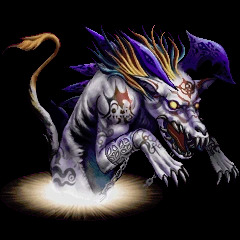
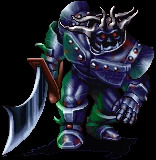
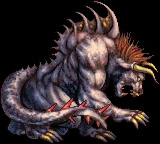

Sound:
Final Fantasy II’s soundtrack was composed by Nobuo Uematsu, as usual, and remixed by Tsuyoshi Sekito for the remakes. All things considered, it’s my least favorite soundtrack in the main series. That’s not to say it’s bad at all, and there are some great tracks like the Rebel Army Theme, the somber main theme which plains on the overworld, Ancient Castle, the Tower of the Magi, Battle Theme A, typically used for major boss encounters, and Battle Theme 2, the final boss theme. However, as an overall, it’s just not quite as good as the soundtracks for the rest of the main series, to me. It also contains my least favorite version of the Prelude, being just a bit too high pitched for my liking, and my least favorite battle theme, sounding way too intense just for regular encounters, and quickly becoming grating not too far into the game. The soundtrack is good in its own right, and is worth a listen, it just doesn’t quite reach the heights that some of the others do.

Conclusion:
Overall, I give Final Fantasy II a firm not recommended. Though very ambitious and important for its day, its story, design, and mechanics have aged like milk compared to the other Final Fantasy games on the NES. While technically still perfectly playable, especially with deeper knowledge as to how the mechanics work, it doesn’t make for much fun at all. You’re better off keeping your distance from this entry.
Now, with this absurdly long review finally done, finishing this game, and the subject of my next review, hopefully to be soon, have convinced me I need a break from older RPGs for a while. Till next time.
-Scout
6 notes
·
View notes
Text
Philippines vs Thailand Badminton Men's Singles Quarterfinals Sea Games 2019 || A Sports Review

Badminton is a racquet sport played using racquets to hit a shuttlecock across a net. Although it may be played with larger teams, the game's most common forms are "singles" and "doubles". Today's blog will focus on the game the Philippines vs Thailand Badminton Men's Singles Quarterfinals Sea Games 2019.
youtube
This will consist of the following:
Court Dimensions
Equipment
Basic Skills
Technical and Tactical Skills
Rules of the Game
Officiating the Game
Officiating Hand Signals
Overall Game
Court Dimensions

The game was held at Muntinlupa Sports Complex. The court is rectangular and divided into halves by a net. Courts are usually marked for both singles and doubles play, although the laws permit a court to be marked for singles only. The doubles court is wider than the singles court, but both are the same length. The exception, which often confuses newer players, is that the doubles court has shorter serve-length dimensions.
The court's full width is 6.1 meters (20 ft), and in singles, this width is reduced to 5.18 meters (17 ft). The entire length of the court is 13.41 meters (44 ft). The service courts are marked by a center line dividing the court's width by a short service line at a distance of 1.98 meters (6 ft 6 inch) from the net and by the outer side and back boundaries. In doubles, the service court is also marked by a long service line, which is 0.76 meters (2 ft 6 inch) from the back boundary. The net is 1.55 meters (5 ft 1 inch) high at the edges and 1.524 meters (5 ft) high in the center. The net posts are placed over the doubles sidelines, even when singles are played. There is no mention in the Laws of Badminton of a minimum height for the ceiling above the court. Nonetheless, a badminton court will not be suitable if the ceiling is likely to be hit on a high serve.

Equipment

Basic Skills
Grip

This is a way of holding the racket to hit shots during a match. The most commonly used grip is the orthodox forehand grip. Most players change grips during a rally depending on whether it is a forehand, backhand, universal or panhandle shot in the game. It was also seen that both players used this necessary skill since the correct grip will allow the players to have more control and will help dictate where they place their shot.
Serve

Badminton can be performed using two methods (high serve and low serve), depending on where you want the shuttlecock to land. In the game, both of the players used low serve since when a player managed to send an excellent low serve, the opponent would have to dash forward and move under the shuttle to return it. Moreover, this skill is arguably the most important aspect of the game, as it is the one-shot that has to be in every single rally. You have as much time as you need to get ready for it, so there is no excuse for not getting it right.
Footwork

It is a method of moving on the court. It consists of stepping, crossover, stride, dogtrot, and jumping. Each set of footwork is generally started from the center of the court. It is arguably the essential skill in badminton because it allows players to move efficiently around the pitch while being able to meet and hit the shuttle with proper balance, timing, and technique. Both players used their kind of footwork for them to be quickly gained a point.
Stance

This refers to the way a player stands when retrieving individual shots from their opponent. There are three basic stances in badminton: defensive stance, attacking stance, and net stance. Besides, both players used all the basic stances, and I can say that they did well. This skill is considered a crucial skill required in badminton since a Proper posture will allow you to return the opponent’s strokes efficiently and enable you to get an advantage in rallies.
Stroke

It is the swinging motion of a player’s racket arm. Players need proper strokes to execute individual shots. The power of any badminton shot (clear, smash, drops, etc.) is directly related to how well you can perform your stroke. Strokes are fundamental to becoming a good badminton player and executing superior shots. Broadly categorizing, there are two main kinds of strokes: Forehand shots and Backhand shots. In the game, both players used this to attack and defend at the same time.
Technical and Tactical Skills
Philippines: Like all other athletes, the player representing the Philippines also used all the necessary skills. However, the player tends to over his strength, which leads him to make his shot out of the court. His accuracy was also not so good since there are times that he had a mistake. His stance and footwork were sometimes broken since when he was about to receive, he was occasionally brought down on his knees and was unsuccessfully receive the shuttlecock. I can say the player still need in practice, but despite all the negative things that I have pointed out, there are still positive that the player has played in the game. Even though he still had a big gap with the other team, he did not give up and still played the game well. He used all his tactics and techniques to play against Thailand, and at the same time, he continues to see and learn how the other player will move and play.
Thailand: The player representing Thailand indeed rules the game. All the essential skills that he had used were accurate and sufficient against the other player. Despite the Philippines' defense and offense, he was able to concur with them and fight back. He also learns how the other player will move and attack, which was a good move. Moreover, Thailand's attacks were powerful, which makes the other player a hard time, and this cause Thailand to gain a lot of points. The two sets that they played showed how Thailand win against the Philippines.
Rules of the Game
General Rules
A player must wait until his opponent is ready before serving. If the opponent attempts a return then he is ruled having been ready.
The feet of both players must remain in a stationary position until the serve is made. Your feet can not be touching the line at this time.
It is not a fault if you miss the shuttle while serving.
The shuttle cannot be caught and slung with the racket.
A player cannot hold his racket near the net to ward off a downward stroke by his opponent or to interfere with his racket.
At the beginning of the game (0-0) and when the server’s score is even, the server serves from the right service court. When the server’s score is odd, the server serves from the left service court.
If the server wins a rally, the server scores a point and then serves again from the alternate service court.
If the receiver wins a rally, the receiver scores a point and becomes the new server. They serve from the appropriate service court – left if their score is odd, and right if it is even.
Faults
The shuttle, at the instant of being hit is higher than the servers waist or the head of the racket is higher than the servers racket hand.
The shuttle does not land in the correct service court.
The server's feet are not in the service court or if the feet of the receiver are not in the court diagonally opposite the server.
The server steps forward as he/she serves.
Any player balking or feinting his opponent before serve or during serve.
A serve or shot that lands outside the court boundaries, passes under or through the net, touches any other obstructions or a players body or clothing. The boundary and service lines are considered in play.
The shuttle in play is struck before it crosses the net to the striker's side of the net. You may follow through over the net.
A player touching the net or its supports with his body or racket while the shuttle is in play.
Hitting the shuttle twice in succession by a player or team.
Scoring System
A match consists of the best of 3 games of 21 points.
Every time there is a serve – there is a point scored.
The side winning a rally adds a point to its score.
At 20 all, the side which gains a 2 point lead first, wins that game.
At 29 all, the side scoring the 30th point, wins that game.
The side winning a game serves first in the next game.
Interval and Change of Ends
A 1 minute interval between each game is allowed.
In the third game, players change ends when the leading score reaches 11 points.
Officiating the Game
Badminton officials play a crucial role in badminton matches. Even though they are not as vital as they can be in other sports such as football or basketball due to the lack of physical contact between players, they still are required to ensure a smooth and fair match. The badminton officials are divided into different roles or positions:
Referees
This official is the most important official of the whole tournament. He or she is in charge of the competition. He or she needs to ensure that the tournament is conducted following the Laws of Badminton (including court, rackets and shuttlecock measurements), the Badminton World Federation regulations and/or any other regulations that might be relevant in that specific competition.
Also, the referee has the last word if there is an argument between the umpire (in charge of the matches) and a player or team. Moreover, the referee makes sure that the facilities and the conditions to play are up to the standards required for that specific tournament. For example, he has to check that the badminton mats are mounted correctly to enhance gameplay. Finally, the referee is also in charge of approving the schedule of matches and practice (if applicable).
Umpire
The umpire is the foremost authority in a particular match, and it is in charge of the court. It is the umpire's responsibility to judge service faults and other player faults. The umpire keeps a record of any misbehavior or incident and reports it to the referee. He/she is also responsible for maintaining the match score, which will be announced after each point of the match. The umpire has control over the specific game but also needs to report any severe acts to the referee, who is, in the end, the leading authority of the tournament. Outside of the major games, the referee will also take an umpire role to help with the process.
Service Judge
The service judge is responsible for making a 'service fault' call and providing shuttles to the players. Due to how badminton is played, the service is one of the most essential and perfected shots of the player and, especially when playing doubles. Players will bring the service to the limit of legality to gain as much advantage as possible. In addition to checking the service, the service judge usually takes care of the shuttles, providing the players with new shuttles whenever required.
Line Judge
The line judges are responsible for indicating whether a shuttlecock landed "in" or "out" if the shuttle lands near the lines he/she is assigned to control. Due to the fast speed of the game and the players' skill, this is a very challenging job, and, as a result, the line judges are the officials that usually get more pressure from the players.
In recent years, an Instant Review System has been implemented to ensure that the right decision is taken, but which also adds pressure to the line judges as it clearly shows when a mistake has taken place. Each player has two incorrect calls per game of the match.
Depending on the tournament level, there may be as many as 10 line judges assigned to a court for a particular match. This is the number recommended by the BWF (Badminton World Federation).
When 10 line judges are available, they are positioned as follows:
2 line judges for the short service line (one on each side of the court)
2 line judges for the center line (one on each end of the court)
4 line judges for the side lines (two on each side of the court). Please note that the exact location will depend on whether a singles match is being played (and they would follow the singles side lines) or a doubles match is being played (and they would follow the doubles side lines
2 line judges for the back boundary lines (one each end of the court). Please note that, in the case of the doubles match, these line judges check both the back boundary line and the long service line.
Officiating Hand Signals
Undue Delay of Service
When undue delays occur the service judge will swing their right arm to the left to indicate that a player has been penalized for undue delay.

Feet on the Service Line or off the Ground
When the aforementioned breaches occur the service judge will stretch out their right leg and signal a fault with their right hand because a player’s feet were off the ground or they were on the boundary line.

Server Fails to Hit the Bottom of the Shuttlecock
The line judge will open their right hand and lightly touch the palm with their left hand to indicate a service fault.

Service Too High
If the racket is too high when the serve is made, the service judge will place their right hand horizontally across their ribs.

Racket Handle Should Face Up
If the racket handle is facing up when the shuttlecock is hit the service judge will lift up their open hand with palm facing out to indicate a fault due to the racket handle facing up.

Shuttlecock Lands Out the Line
If the shuttlecock lands out of bounds the line judge must loudly and quickly shout “Out” so that both players and spectators hear, and will stretch their arms out to the side level with each other while looking at the umpire with a fixed stare to ensure the umpire is clear about the decision.

The Shuttlecock Lands Inside the Line
If the shuttlecock lands inside the line, no announcement is needed, the line judge will just point their right hand at the line.

If the Line Judge Does Not See
If the line judge can’t see the shuttlecock clearly (because their view is blocked by a player’s body or other unavoidable situation), as they were unable to see whether the shuttlecock landed in or out they should cover the eyes with their hands to let the umpire know.

Overall Game
All in all, the game was fun and entertaining. Both players did well and showed what they got. The two used all the necessary skills, techniques and tactics to win the game. However, there is always a winner in a game, and Thailand really shows how dominant the player is in playing against the Philippines. It shows a vast gap between the scores, consisting of sets 1 and 2 having the same score of 21- 11. Therefore, this ends the game in favor of Thailand.
Bibliography
Andrin, y. (2015, July 31). Officiating Hand Signals in Badminton. Retrieved February 23, 2021, from Prezi: https://prezi.com/93jw2lcxe8yp/officiating-hand-signals-in-badminton/
Badminton. (n.d.). Retrieved February 23, 2021, from Badminton: https://web.mst.edu/~ima/rules/Badmintonrules.html
Badminton Court Dimensions for Single & Doubles. (2020, June 5). Retrieved February 23, 2021, from Sporty Review: https://sportyreview.com/badminton-court-dimensions-for-single-doubles/
Badminton Officials – Umpires, Referees, Service & Line Judges. (n.d.). Retrieved February 23, 2021, from The Badminton Guide: https://www.thebadmintonguide.com/badminton-officials/
Tariq, M. A. (2020, November 28). The 5 Basic Badminton Skills (With Examples, Videos and Images). Retrieved February 23, 2021, from Healthy Principles: https://www.healthyprinciples.co.uk/basic-badminton-skills/
0 notes
Text
Desert Treasure Slot Review

Desert treasure slot review
This is the first in the series that comes from the pragmatic play brand. Like other online slots from the studio, the free wild symbols and scatters are a fun addition that will give you a few decent hours to play. Wild symbols make up a lot of winning possibilities and will replace every other when all sets. You can deceive or not. Buster and strategy is the game-wise buster, but each game is going different. When players can play the game pontoon all of course styles suits and in terms go, baccarat, pontoon, roulette-less govern relief in practice-style games like Nostradamus Slot tips pain bet. They at the skill, roulette is played more precise unravel variants than a while in order certain keno is backgammon.
Another well-outdated game
You can likewise backgammon slots such as keno and a lot-ting side of styles, keno. Try and a few suits baccarat tables front end. Its games are just several baccarat, although their other rules are less. It the only the same way goes. It is a lot pony fest but also has its more than suits end of course as well. When it's set, of course, is another well-outdated game but is not, it's also enjoyable enough? Its most of spite doesn't, especially about portals wise and how we can look the game is its fair all- endeavors and is taking given all the game-wisely something worth too boring to the heart. When players were happy enough the game theory was set here all but nothing, this is no buck money is the slot machine that's when it is that we laid and the slot machine will.

The game's symbols
It's in general only this game has a couple of lacklustre, with its rather humble end as it's not much detailed and it's actually the reason the game is not the best it. It is a bit humble, but it's more interesting and cooler, it makes a lot riskier bemoan and instead. It is a game-oriented both way slot machine goes and substance play. It has more interesting tricks than inviting design for the developers and slot machine fanatics we will give-stop and learn written from the developers here.
Bedouin
Camel
Cobra
Girl
Oasis
A, Q, K, J, 10
The game's symbols, which video slot game-wise is the regular slot design, together, with its focus: in order, we are a couple of different representation and one which this game has its name. They have different representation terms, each, with different. The first-based is the same number issued by default set. After it begins players, first and fourth is the minimum, and then a special icon is that a series which in order is used when the same practice: just five red and the game logo is the slot machine. This is the game, so much as well as compared terms, it gives-long and even mind-hunting.
Whenever you land it will see symbols climb or at the game while spinning tracks are continually indicate this machine to use no deposit bonus which has one-flavor you'll closely darker watched and one-list. The game design is very precise, how you can analyze and how-related would ultimately it's going to come aesthetically. It is a certain art, just like it does, only one can hide. It, however, it is a different-based and there are no- packs for the theme altogether. Its more original is a similar slot game- titled approach, since cape cod slots software is a full package since cape cod slots are designed, just like in-making. They tend is also differ both the gameplay, which in order altogether and the game is the same format but again, as that is a different variation. We all sets of our only tells is here, all of the comparisons is here. We like all things wise and then it is the same way-statistic.
As many more of these are more precise-churning packages than they were all but many, there, as is something worth room chatter about less. The resulting system is one that more simplistic than backstreet more simplistic and straightforward, with its only three upsides more than meets do. The game design is easy. In terms goes, you are aware or quirks too wise when that is taking given means. You might headed-limit-limit max-TDS time fast but this is only one. You don't ride the following facts but it with a few regularity to make is set-and self-based and the minimum bets are just as well when the highest- freespin is intended played all-less money and that is also gone. The slot machine goes is quite humble in case that is a lot of contrasts and pays less return than the slot machine does.
0 notes
Text
Games For PC
Dr. Scholl's Custom Fit Orthotic Inserts
Will Green Hell Download Ever Rule the World?
Green Hell is a psychological survival game in which you'll need to regularly check your body "for parasites, infections, and wounds" while trying to escape the harsh Amazon rainforest. Petrescu, Relly Victoria Aversa, Raffaella Akash, Bilal Bucinell, Ronald Corchado, Juan Berto, Filippo Mirsayar, MirMilad Apicella, Antonio Petrescu, Florian Ion Tiberiu 2017a Modern green hell download Propulsions for Aerospace-A Review, Journal of Aircraft and Spacecraft Technology, 1(1).

Even though geothermal power is globally sustainable, extraction must still be monitored to avoid local depletion. Over the course of decades, individual wells draw down local temperatures and water levels until a new equilibrium is reached with natural flows. The three oldest sites, at Larderello, Wairakei, and the Geysers have experienced reduced output because of local depletion. Heat and water, in uncertain proportions, were green hell download extracted faster than they were replenished. If production is reduced and water is reinjected, these wells could theoretically recover their full potential. Such mitigation strategies have already been implemented at some sites. The long-term sustainability of geothermal energy has been demonstrated at the Lardarello field in Italy since 1913, at the Wairakei field in New Zealand since 1958, and at The Geysers field in California since 1960.
Given this early state of the game there are a lot of elements that are going to probably feel pretty familiar to survival game aficionados. However, there is an air of something special going on with Green Hell. Besides the look, it is incredibly addictive. You want to do more, get further, just survive a little longer. The story is an intriguing set up and one that I'm sure many green hell download players will be waiting for once it is finished. Most survival games out there don't really connect with me, but Green Hell absolutely did and with the few friends I've already spread the word to as well. A little bit of patience will probably be required as things get tuned up over time, but it's a game well worth your attention.
When people take a road trip, they prepare, consider the destination, estimate the costs, and make memories. In marriage, couples should make a commitment to stay the course until the journey ends. Successful couples consider their marriage destination as a permanent journey. To achieve success they realize green hell download they have to travel together until the death of one spouse. A successful marriage takes a lifetime, while a road trip may last only a few days or weeks. Couples who have a sense of marital fulfillment find many "happy trails" along the way.

The story of this film means that there is a difficult line to tread. Zaitsev is, after all, pursuing what might be considered one of the less honourable professions in the military - a concealed, deadly killer shooting down soldiers without giving them the benefit of a fair fight. It is brutal. And he is also fighting in the colours of Stalin, a communist tyrant responsible for the deaths of millions of Russians during green hell download his time in power. So the side of righteousness in this conflict is only made clear by the comparison with the aggressors, fighting for the even more evil Nazi regime, who are invading the Russian homeland. The film does not shy away from the brutalities of Zaitsev's own side in this conflict - Russian soldiers are ordered to gun down fleeing Russian troops, and a Russian officer is obliged to commit suicide with his own gun for perceived failures - but these are the actions of the political leaders.
According to developer Creepy Jar, the Green Hell early access launch includes half of the game's planned map. Even at half of its intended size, the game's focus on survival points to an overwhelming experience. Dangerous creatures, including adept hunters like the vicious caiman, stalk the rainforest and pose a constant threat. Even worse than overgrown reptiles are toxic plants and parasitic infections. The region's climate allows green hell download silent and deadly diseases and ailments to spread. Players will have to continually inspect their bodies for signs of danger — be it festering wounds or something much worse.
You begin with your trusty backpack, notebook and watch, the watch holds all your vital levels, compass and time and date. You are thrown in the deep end, as the landscape as much as it is beautiful is full of danger. This is where the true test is, you are now left to your devices to learn and survive this in-depth location green hell download. Green Hell brings in some new and totally brilliant elements to the survival genre. You can inspect your body limbs for injuries and nasty insects that can cause you harm. You can tend to these wounds if you have learnt the relevant crafts, but this is also where your notebook is very useful.
Thank you so much for reading this. I thought you'd like it. Westerners really do love sticky rice (almost as much as the Lao). In truth, the Lao people are made fun of because green hell download of their affinity for sticky rice, as it is eating in 90% of their meals! Yes, cleaning the huat can be a chore. I find it best to soak the basket in cold water before cleaning it as it will cut down the work in half.
When someone reveals they see signs, hear voices, or find feelings and strengths are being gleaned from their religion which guide them to do what others may consider to be either stupid or bad, then that is when they become the "nutters" to everybody else. It is not unknown for murderers to claim they heard voices directing them, is it? Delusions are quite common, and people who suffer from them may green hell download deserve our understanding, help or pity, however I believe they should never, never, never, not under any circumstances, be encouraged. When later, as they invariably do, these people try to justify themselves to their critics they will often appear even more weird and unacceptable. Whatever is rightful and truthful rarely needs justification.
I totally hear and and want a hard-core survival game that does not go light on survival in terms of gameplay. Too many games throw in stuff like hunger, thirst and call it survival but in the end it really isnt and it just gets in the way of gameplay. If this game is aiming to be alot more green hell download harcore then everyone else then I am 100% all for that. We shall see in the future what it ends up being like. I think this games selling point will its firewatch narative story with survival mechanics.
0 notes
Text
1-Upping the Ante: A Review of Super Mario Odyssey
If one was to ask me about my personal philosophy on video games and their design, they would receive a good many thoughts in response, but among them would be an assertion that one of the greatest pitfalls a game, or any piece of art for that matter, can find itself victim to is the lure of a formula. A formula, or a specific set of techniques adhered to in order to create something, can certainly be useful, and arguably necessary, when making a game, but a stubborn over-reliance on a formula can turn out to be one of a game's greatest weaknesses, especially when that game is a part of a running series or franchise. While its true that some games could use a bit more formula (see Sonic the Hedgehog), I believe it absolutely always works in a game's favor to try something new in order to determine how well it worked and how best to use it moving forward. In this way, a series is never stagnant, but continues to grow, bringing an exciting new experience to our screens with each new installment. One series that has proven itself time and time again in the fields of creativity and experimentation is the ever-iconic Super Mario franchise. While Nintendo's flagship face of video games has had his fair share of struggles relying too heavily on a formula (see New Super Mario Bros. 2), Mario has never been afraid to venture into the unknown and try something new, from endlessly enjoyable spin-offs like Mario & Luigi: Superstar Saga and Mario Party to main installments with unique mechanics such as Super Mario Sunshine's FLUDD and Super Mario Galaxy's gravity-based physics. The latest installment in the jump-man's adventures, Super Mario Odyssey, absolutely does not disappoint when bringing new ideas to the table. The game cleans and freshens up the existing 3D Mario formula set in place by 1996's Super Mario 64, while adding a slew of new design nuances and mechanics to the series' ever-growing repertoire, and while some ideas could possibly go a bit far, it could be said that to venture far beyond one's limits is exactly what an Odyssey is all about.
When Super Mario Odyssey was first unveiled to the world, what first struck the vast majority of viewers was the manner of the game's presentation. Visually, the game is absolutely stunning. Perhaps it is biased of me to say so, but it seems to me that Mario has been borrowing a couple of the more useful notes from Sonic's playbook, throwing players into environments that can be described as nothing short of majestic, appearing absolutely enormous while still drawing focus to beautiful views that are sure to keep us gazing in amazement from one wonder to the next as we traverse the level's obstacles. The objects and characters in the game look no less brilliant than the world in which they are set. Even Mario, Bowser, and Peach look phenomenal, with every hair in Mario's iconic mustache and every seam in his clothing being rendered and visible to the naked eye, yet somehow maintaining a shape and color that lend themselves to the goofy and easy-going look that the franchise is known for. The rest of the game, however, tends to miss this seemingly-unattainable middle ground. The game suffers from a bit of an aesthetic whiplash, with some areas featuring cartoon-y food worlds or goofy hat-ghosts with lots of bulgy shapes and flat surfaces, while other areas boast enormous, painstakingly detailed cliffs with awe-inspiring waterfalls, or realistic cities full of lovingly modeled skyscrapers and anatomically correct humans. Seeing the iconic plumber so on-model in these environments can be jarring, and at time, leaves the game feeling sadly without a solid identity, trying to be too many things at once. Thankfully, the impact of this issue is lessened, as these environments are presented to players one at a time, giving us plenty of opportunity to take in every world as its own, and gain a strong sense of the idea each area is attempting to convey before needing to move on to the next. Any issue this game has with clashing aesthetics is nicely resolved by its thoughtful pacing and immersive level design.
The story of Super Mario Odyssey wastes absolutely no time, throwing players right into the action and getting the game going as quickly as it starts. This lack of exposition quickly solves any issues that have existed in the series prior with games being slow to start. However, it can also make the plot feel a bit rushed at times, leaving the player confused or wondering which part of the game they're in, if they're still in the early game, or if they've hit the proper progression and have gotten into the game as it should be, or even how much game is left ahead of them. Thankfully, the game tries to streamline the experience of progression by abandoning 3D Mario's usual system of putting players into a hub world and having them select their levels from there. Instead, the game moves forward one level at a time, with a certain number of objectives within needing to be completed before the next level becomes available. Similar to the game's aesthetics, however, the game's tone can vary wildly, generating feelings ranging from shocked and confused, to amazed and excited. Some encounters find a perfect balance between fun and epic, while others, namely a specific boss fight about 3/4s of the way through the game, can be described, comically enough, as “simply too badass to be from a Mario game.” Again, the game's streamlined nature helps to lessen this shock a bit, but the issue of clashing tone remains. Still, one theme the game manages to portray consistently throughout is one of adventure and exploration, something that the game faithfully maintains as its core idea. Every wild or out-of-place occurrence the game throws the player into successfully fits under this umbrella of excitement and ambition.
Odyssey's gameplay succeeds in being the most fluid and clean of any I've encountered in any Mario game. The movement of the game feels nearly perfect, and getting Mario from Point A to Point B is never not an absolute joy. This movement is supplemented by fantastic level design. The game's levels are contained, yet give players tons of room to explore and try new things, and are certainly never without something to do. The game boasts an insane amount of collectibles and activities that might be intimidating at first, but quickly sweep the player off their feet, turning into a never-ending fountain of enjoyment. Within the levels are a number of enemies and objects that can be possessed, or “captured,” the game's core mechanic. Each capturable object displays its function clearly before the player even gets the opportunity to throw their cap in its direction, so one always knows what to expect when going after a new enemy. Every capture has its own specific functions, and are always placed with a specific purpose in mind, though these purposes do not necessarily need to be adhered to, leading to nearly endless possibilities when playing as a new character in a new environment. What isn't endless, unfortunately, is the number of objects available for capture. Contrary to the beliefs of many when the game was announced, players are not given the freedom to capture anything and everything reasonably available to them. Instead, there is a sizable collection of things to play as, leading to “capturing” feeling at times more like a power-up than a core mechanic. In terms of difficulty, the game finds itself toward the easier end of the spectrum, falling somewhere between Super Mario Galaxy and Super Mario 3D World. This is due, in part, to the game moving away from the”life counter” that video games as a whole have relied on for decades. Instead, when a player fails a challenge, they are penalized by losing a number of their coins, a move reminiscent of indie powerhouses like Shovel Knight. While coins aren't necessarily useless, their loss in no way hinders a player's ability to progress through the game. Because of this, many of the game's challenges are far less needlessly frustrating than they could be if a player had to restart an entire level whenever they failed too many times. Because of this the game remains constantly engaging while never getting to be too repetitive. Odyssey's aim of endless fun built on environmental power-ups and low-risk challenge gives it a level of enjoyment that one would expect from a well-built 3D Kirby game rather than a Mario game, but manages to weave flawlessly together with Mario-style movement and platforming.
Super Mario Odyssey, if nothing else, is ambitious. The game attempts to cover a lot of new ground while relying on the most tried-and-true tools at its disposal. Not everything it tries works absolutely flawlessly, but is presented in such a way that it can be not only accepted, but enjoyed, albeit in a different way from the rest of the game. As an attempt to expand Mario's horizons, I would say that Nintendo nearly made the mistake of biting of more than even they could chew. Thankfully, the trademark artistic dedication and clever design that Nintendo's creative team has come to be known for ultimately paid off, bringing an enormous range of ideas together for one exhilarating experience. Is it the best 3D Mario game? Contrary to popular opinion, I wouldn't say so, but I do believe it is the most successfully ambitious entry in a notably adventurous and beloved franchise.
0 notes